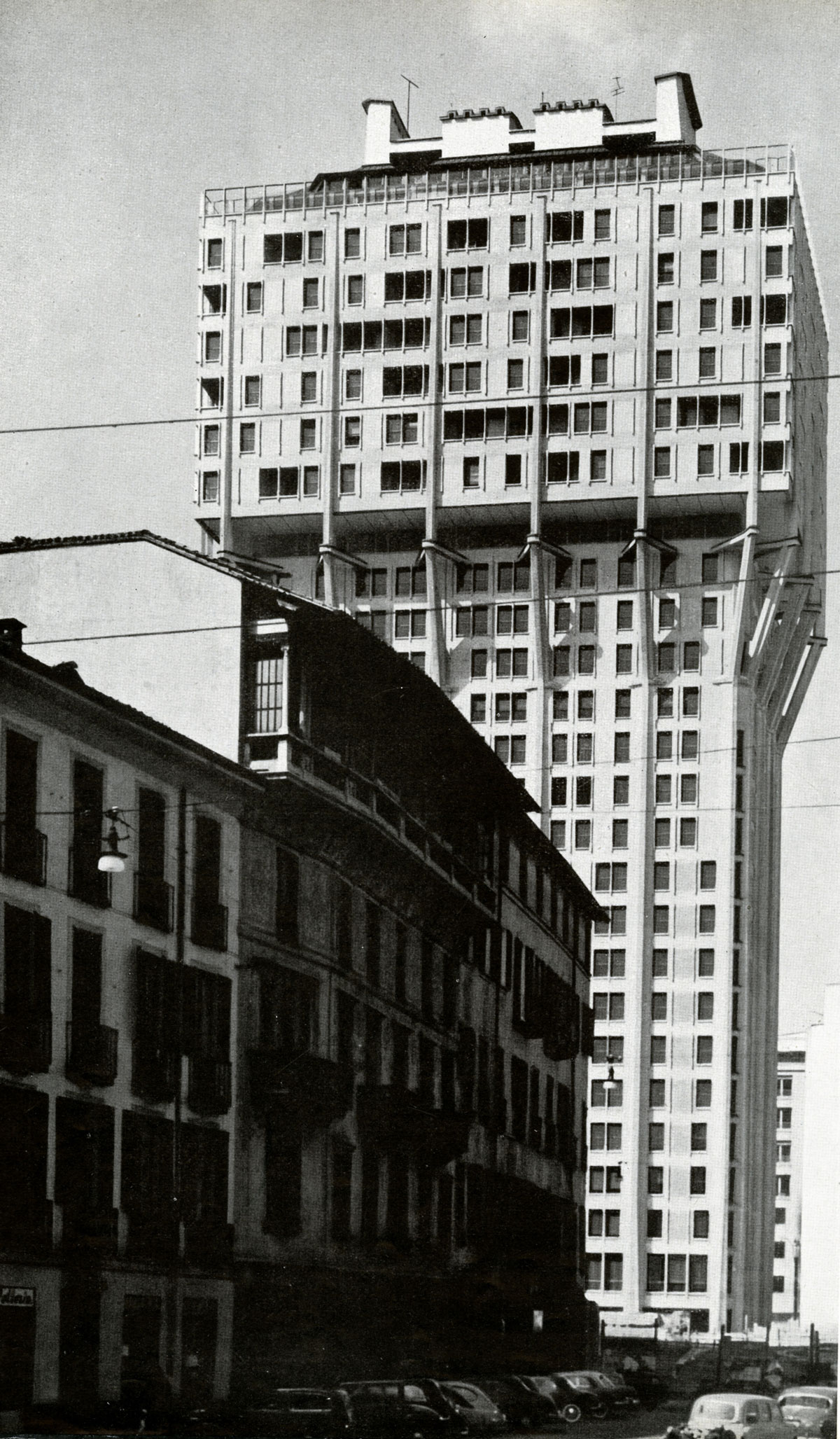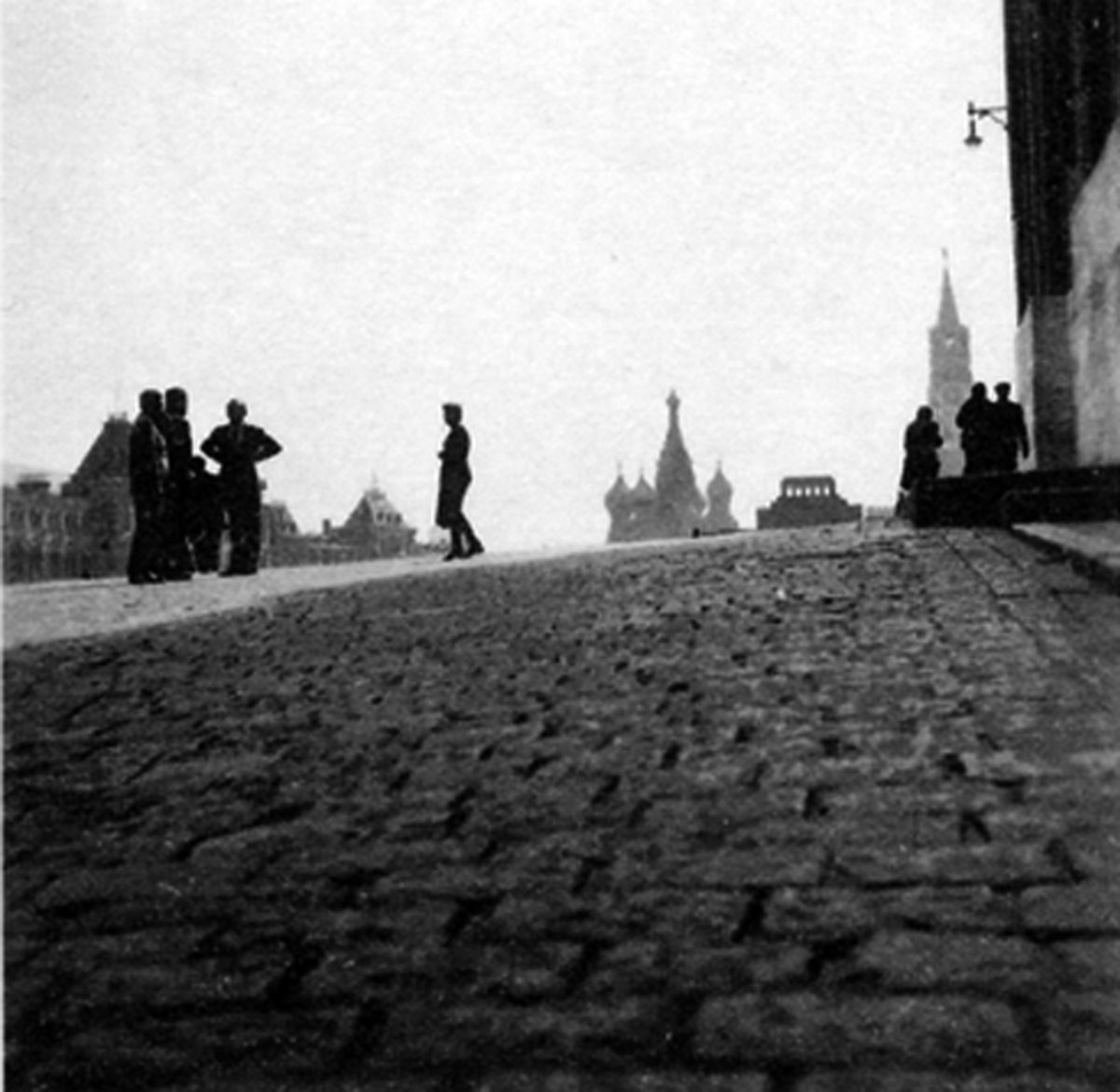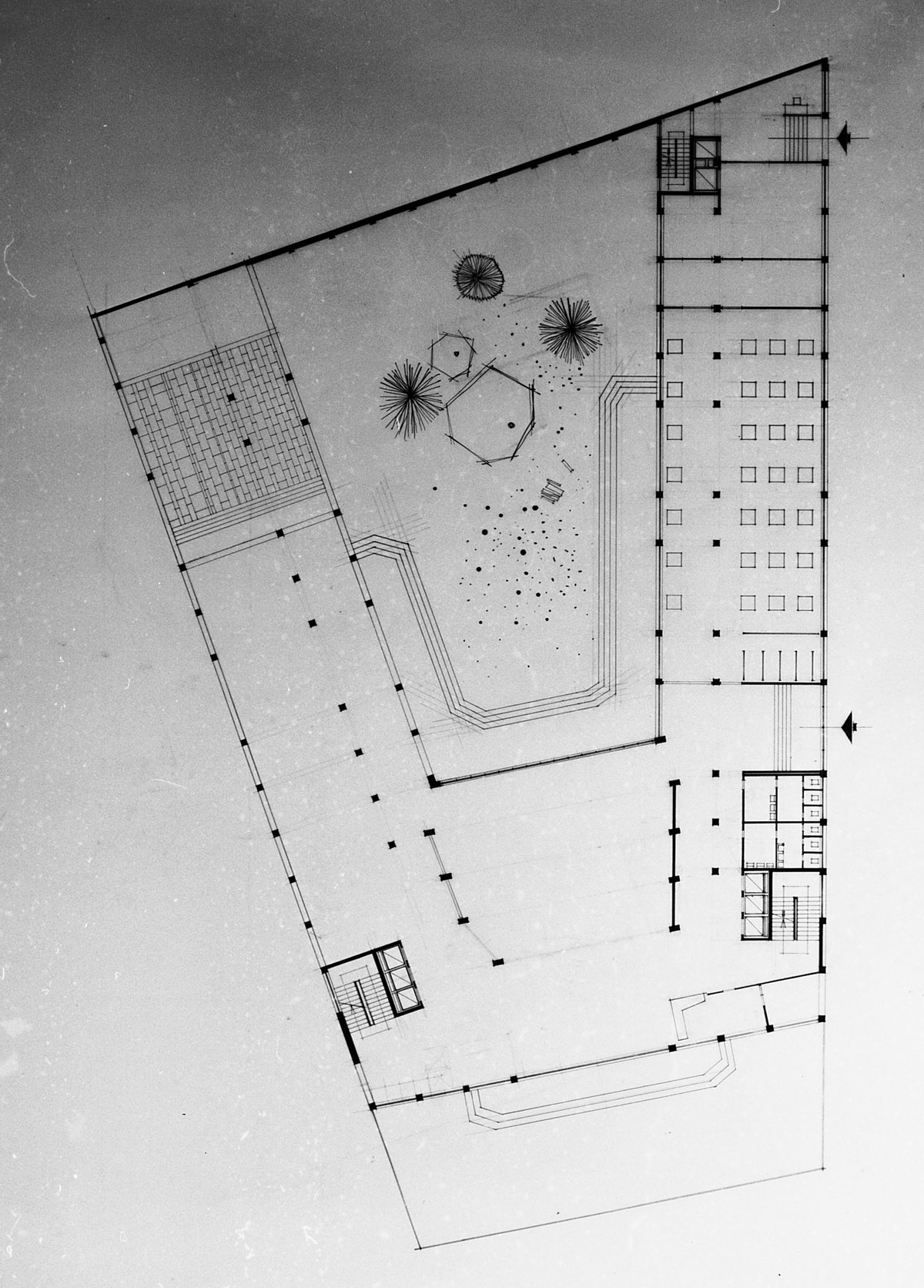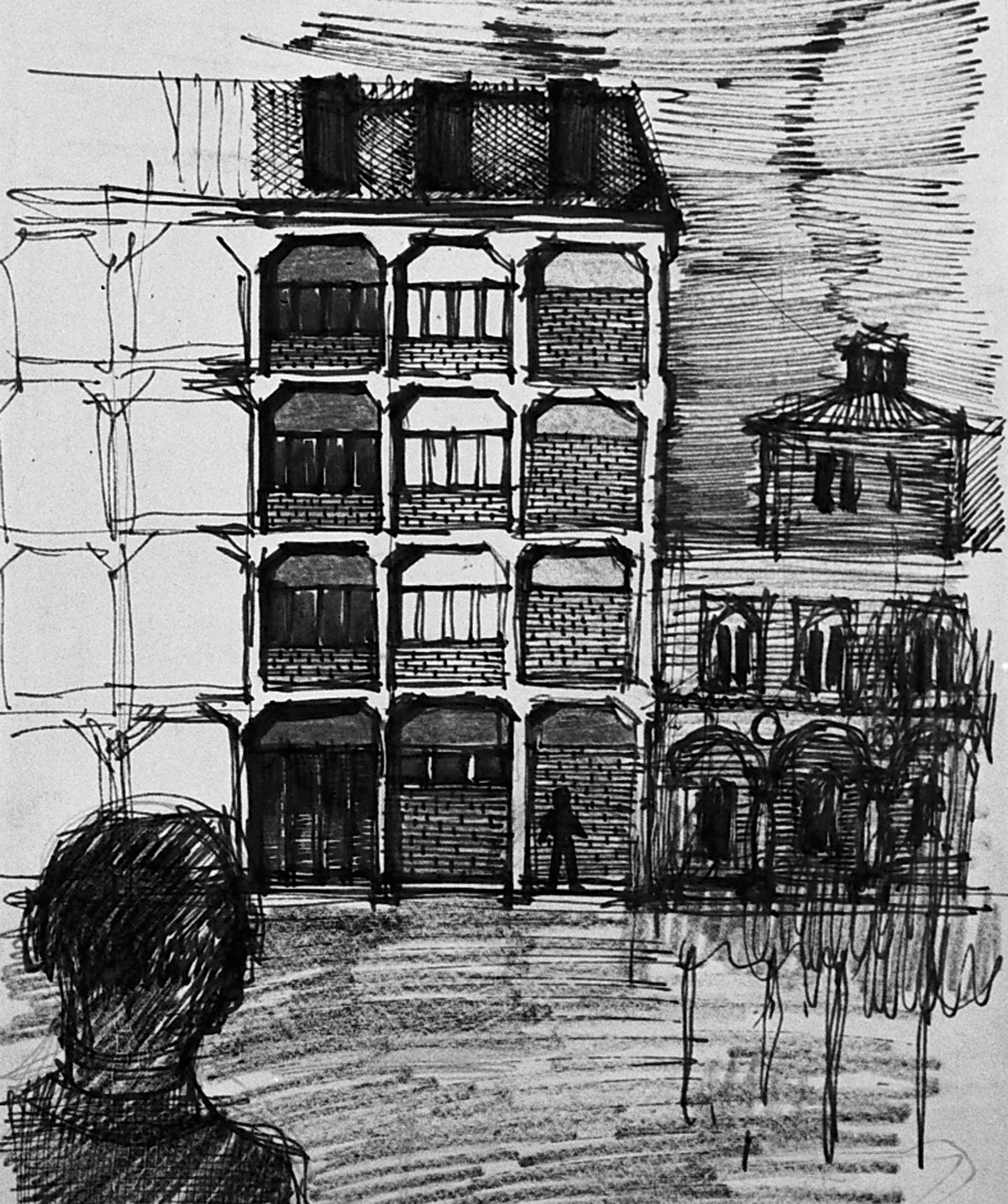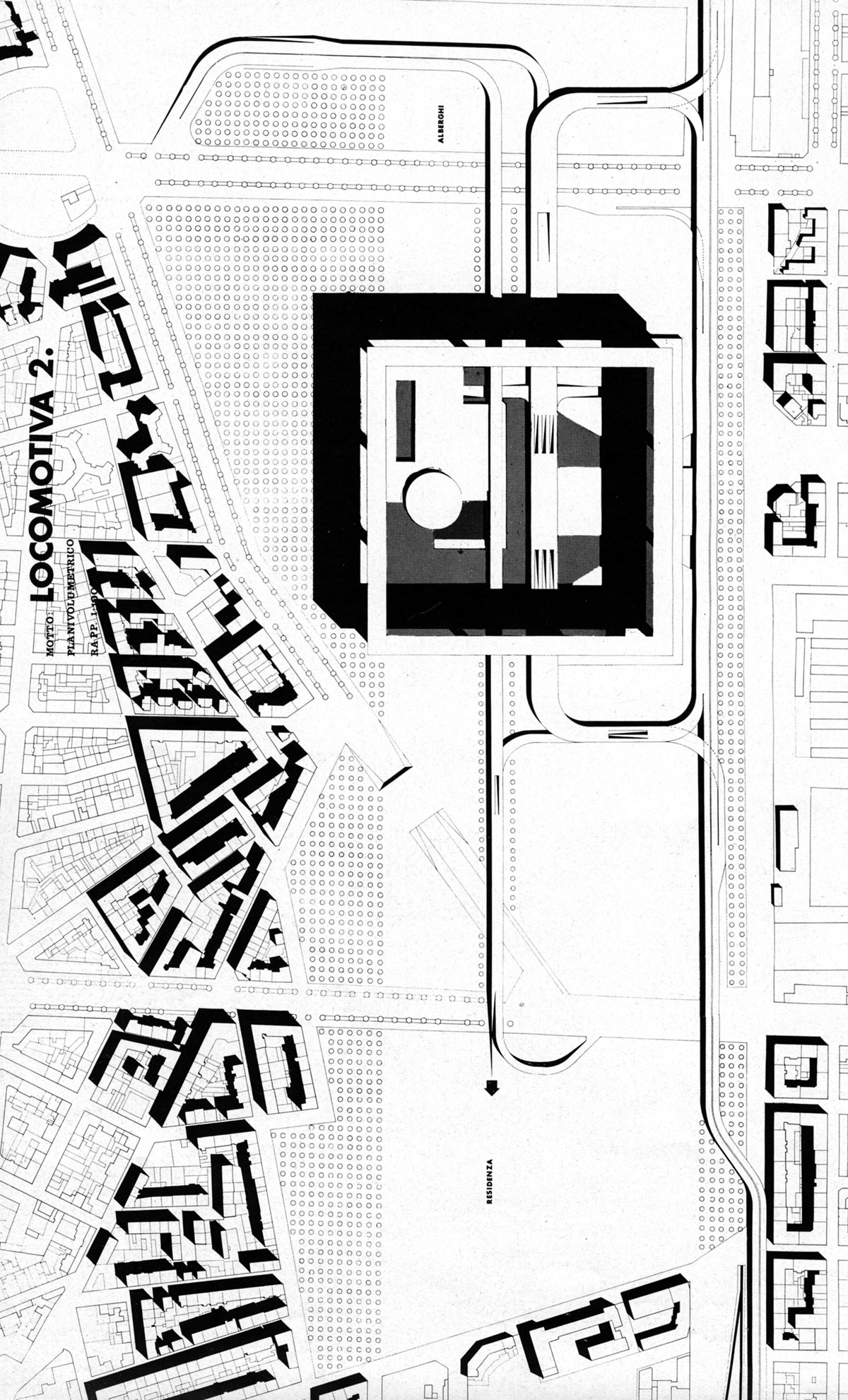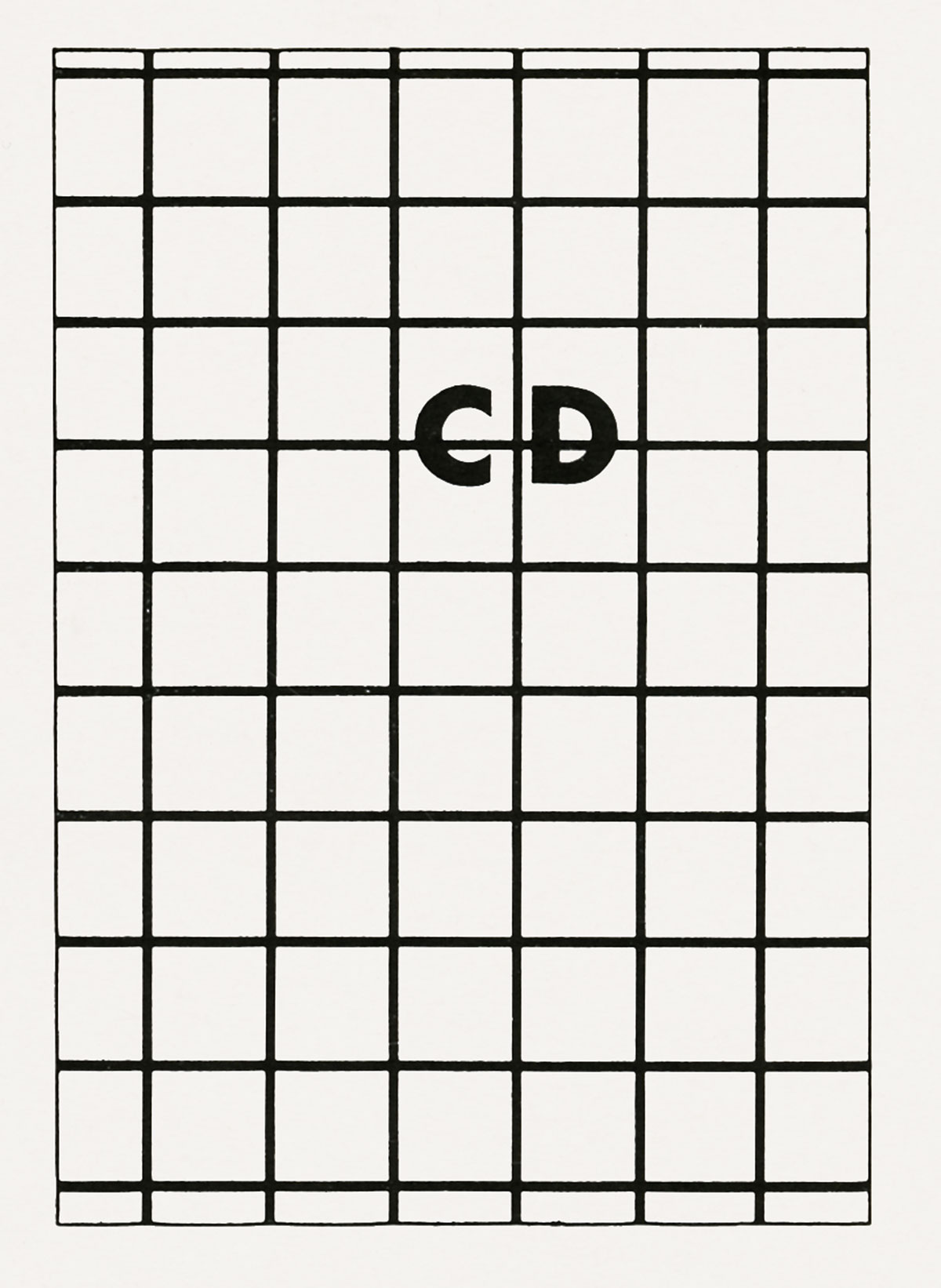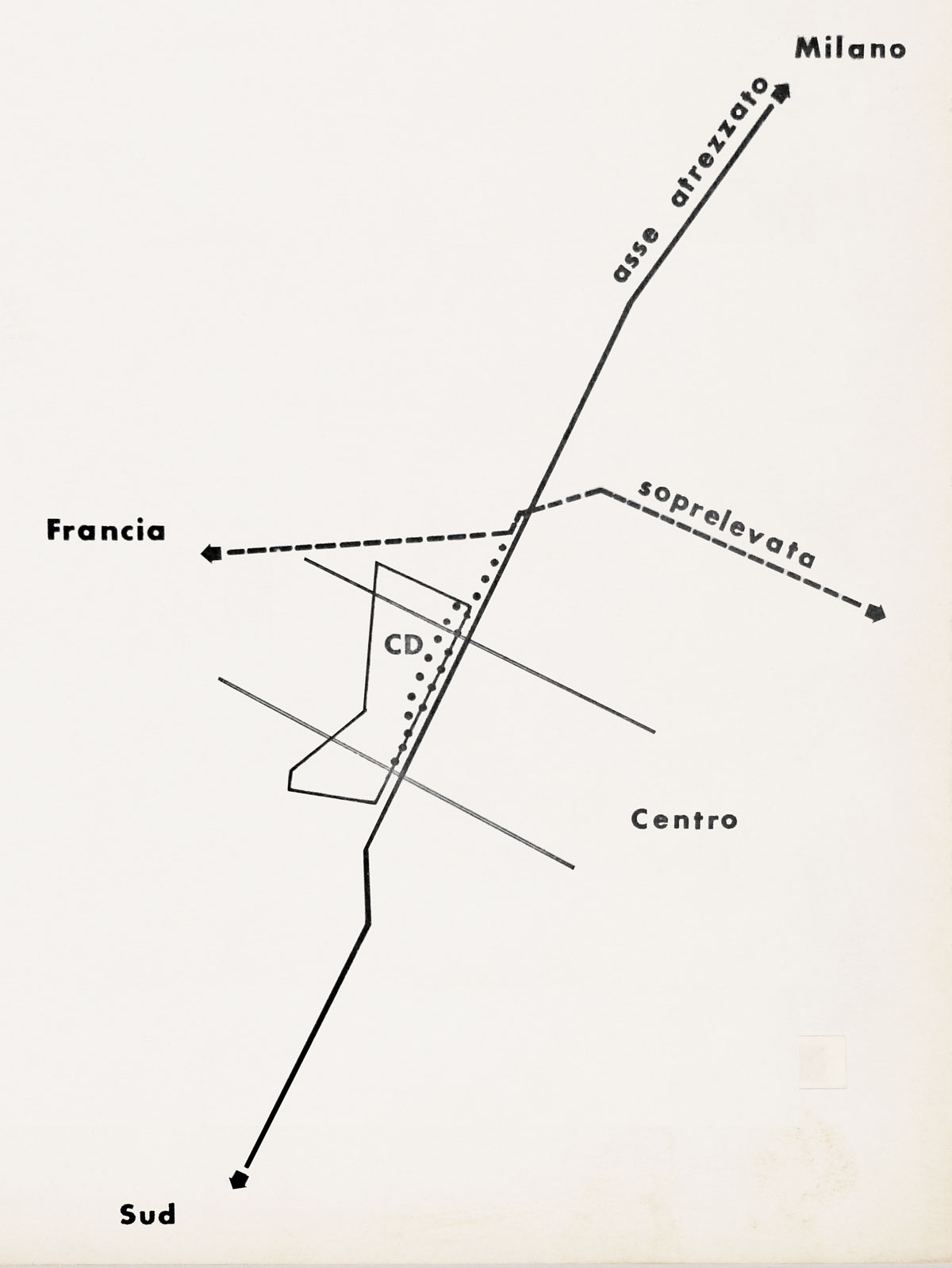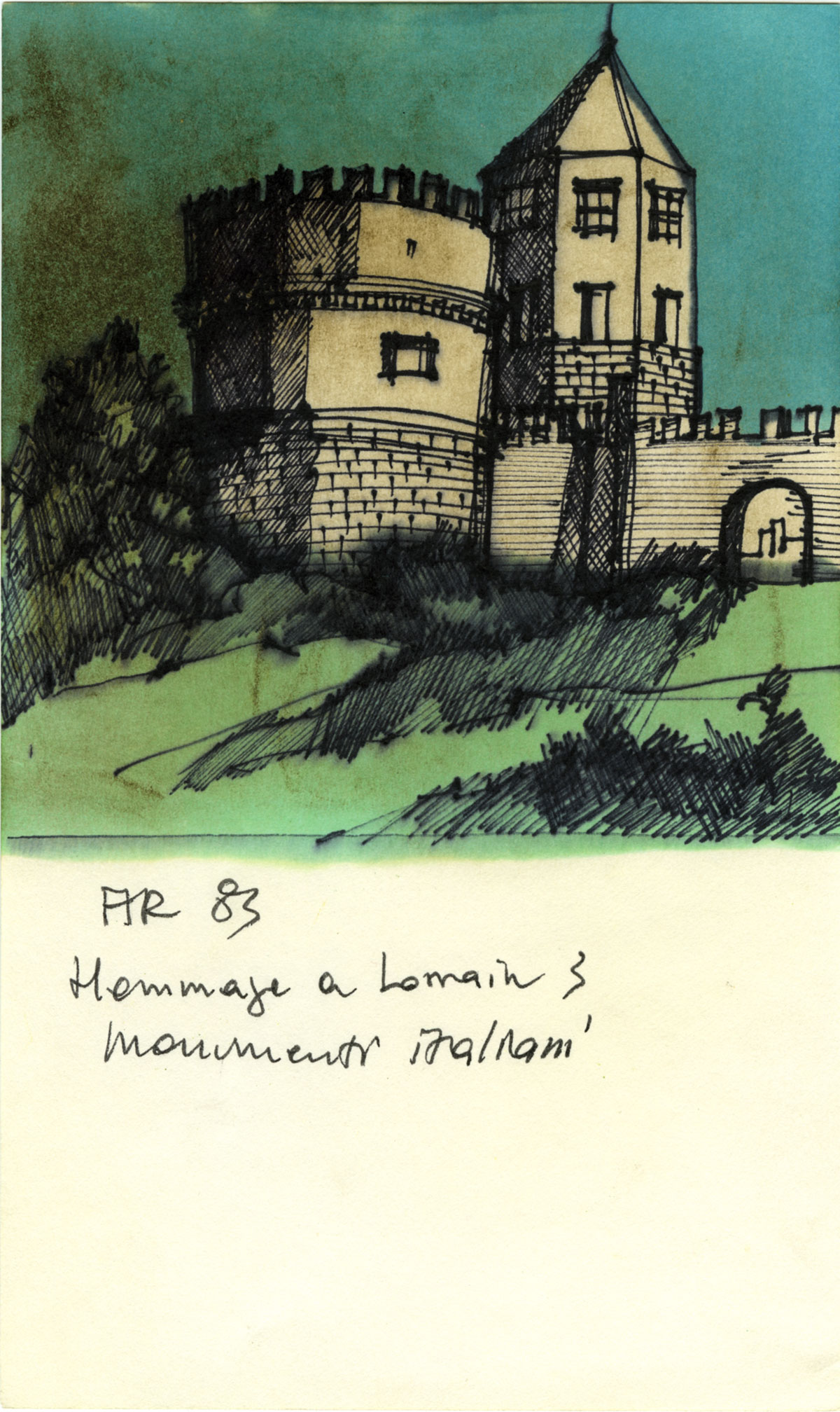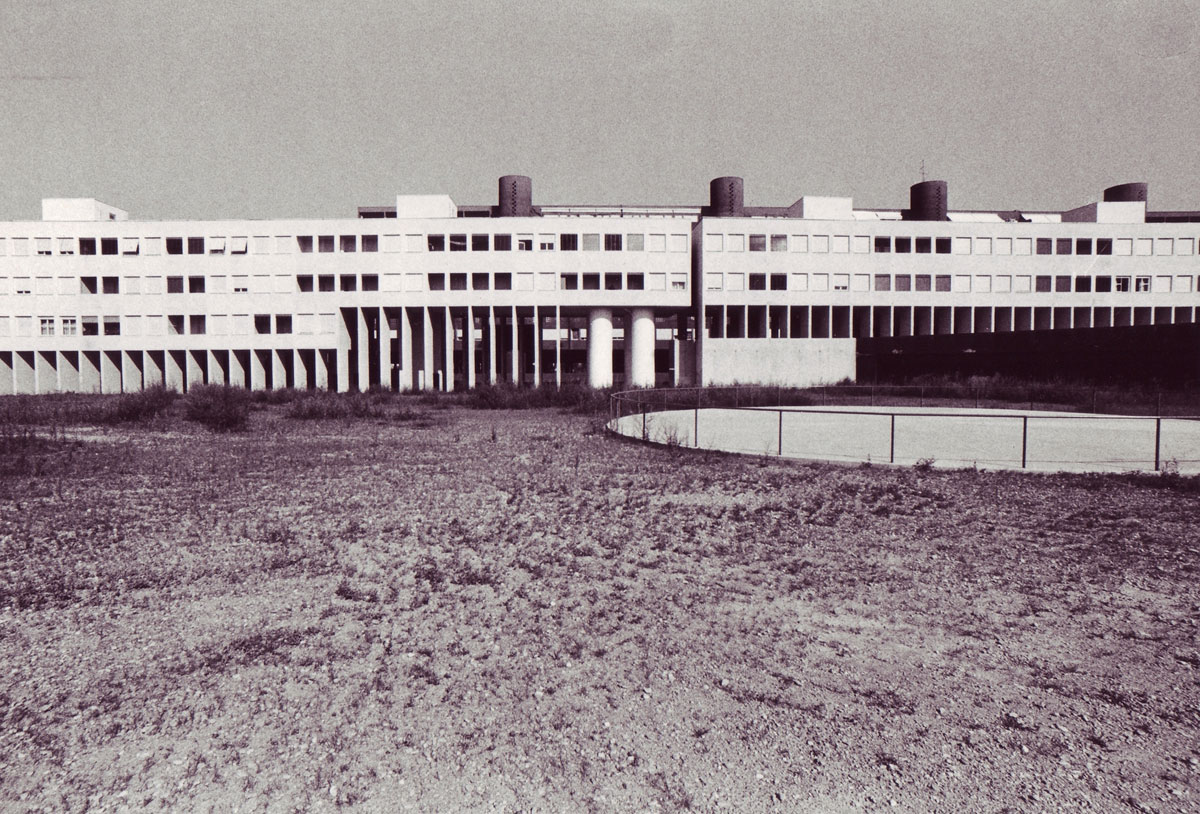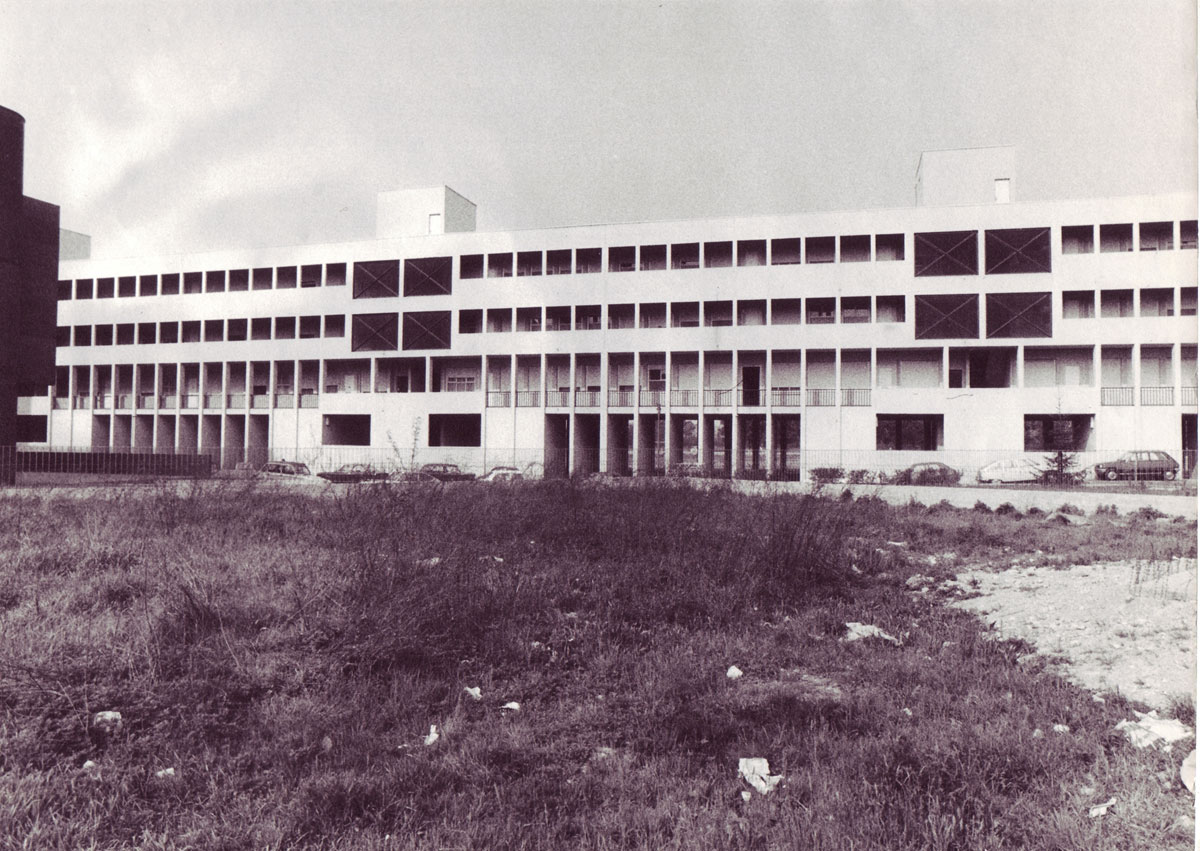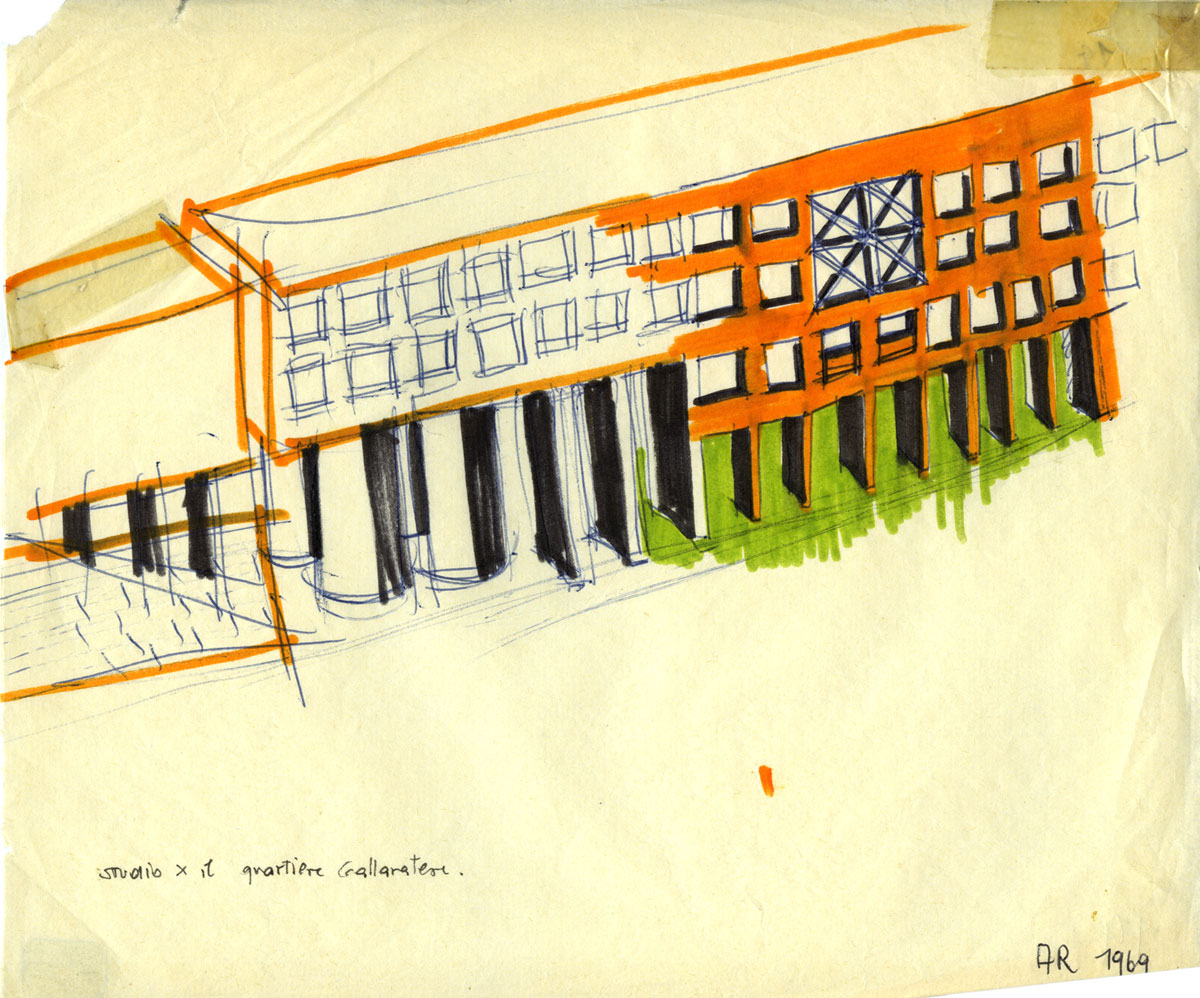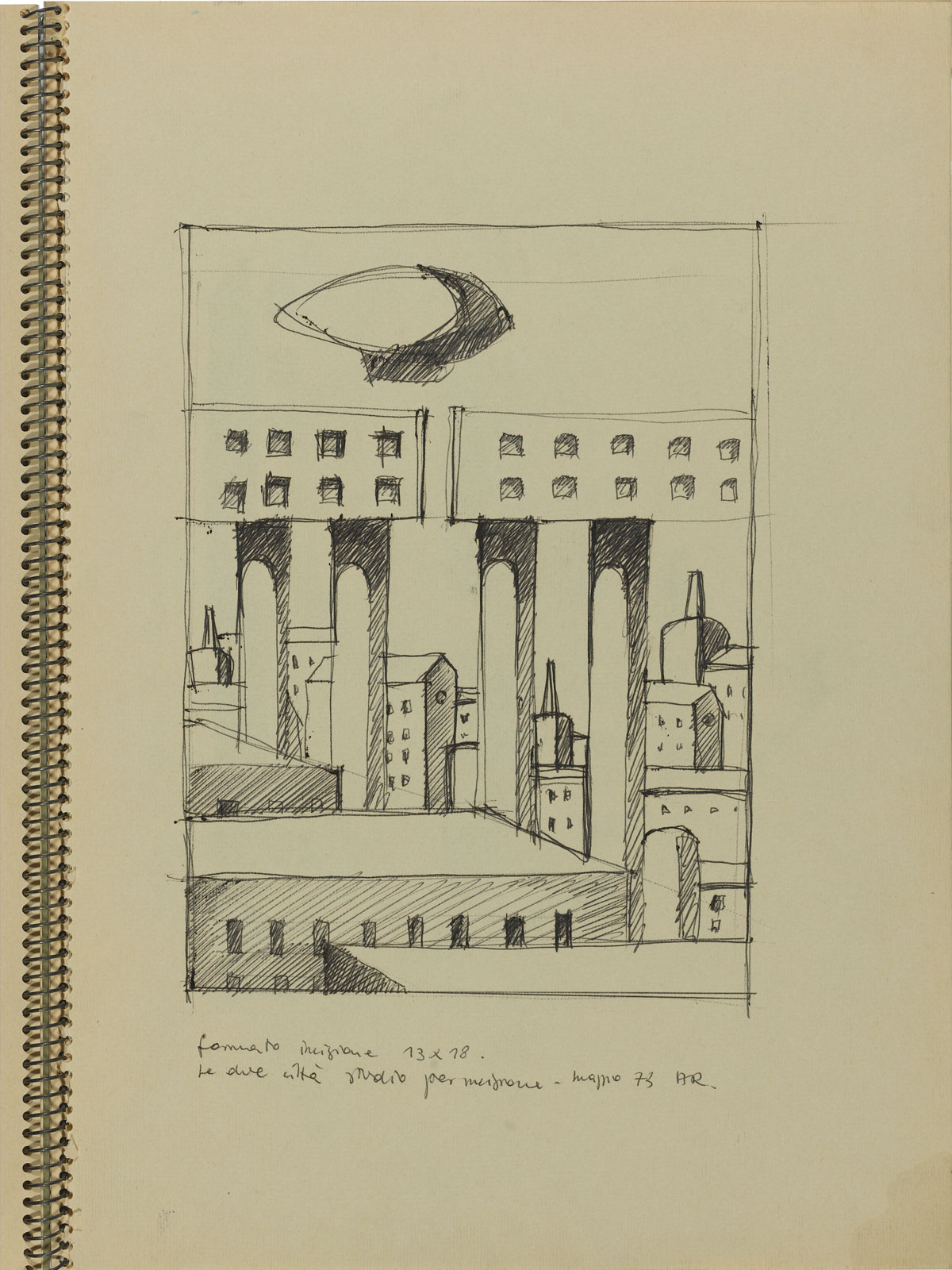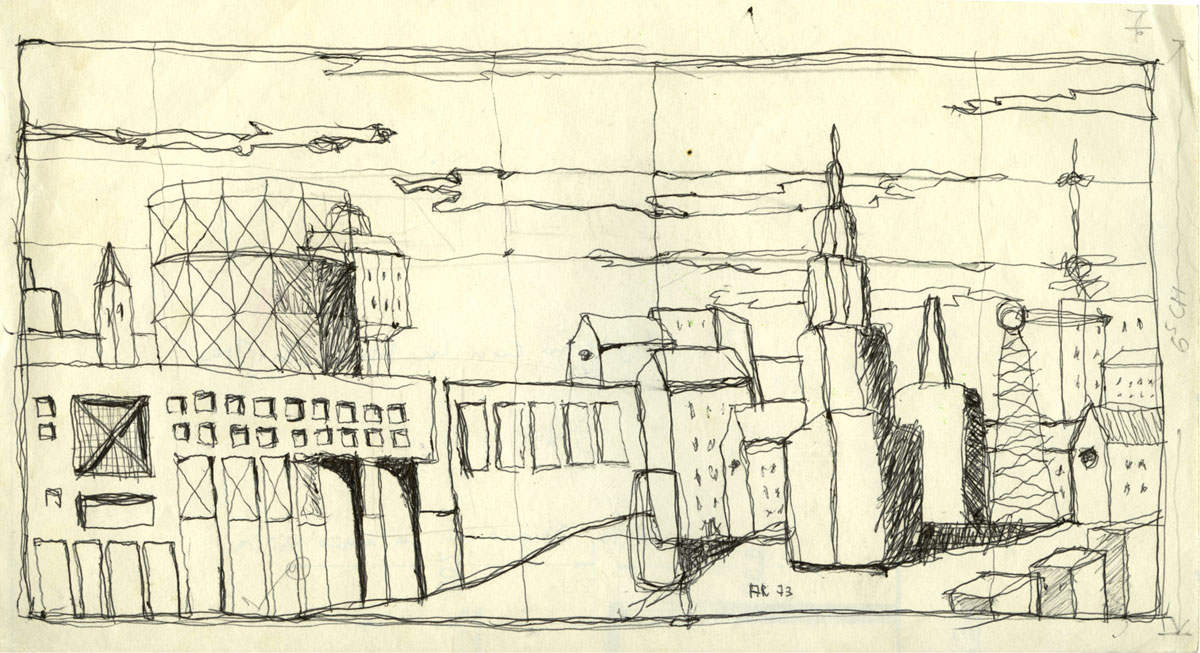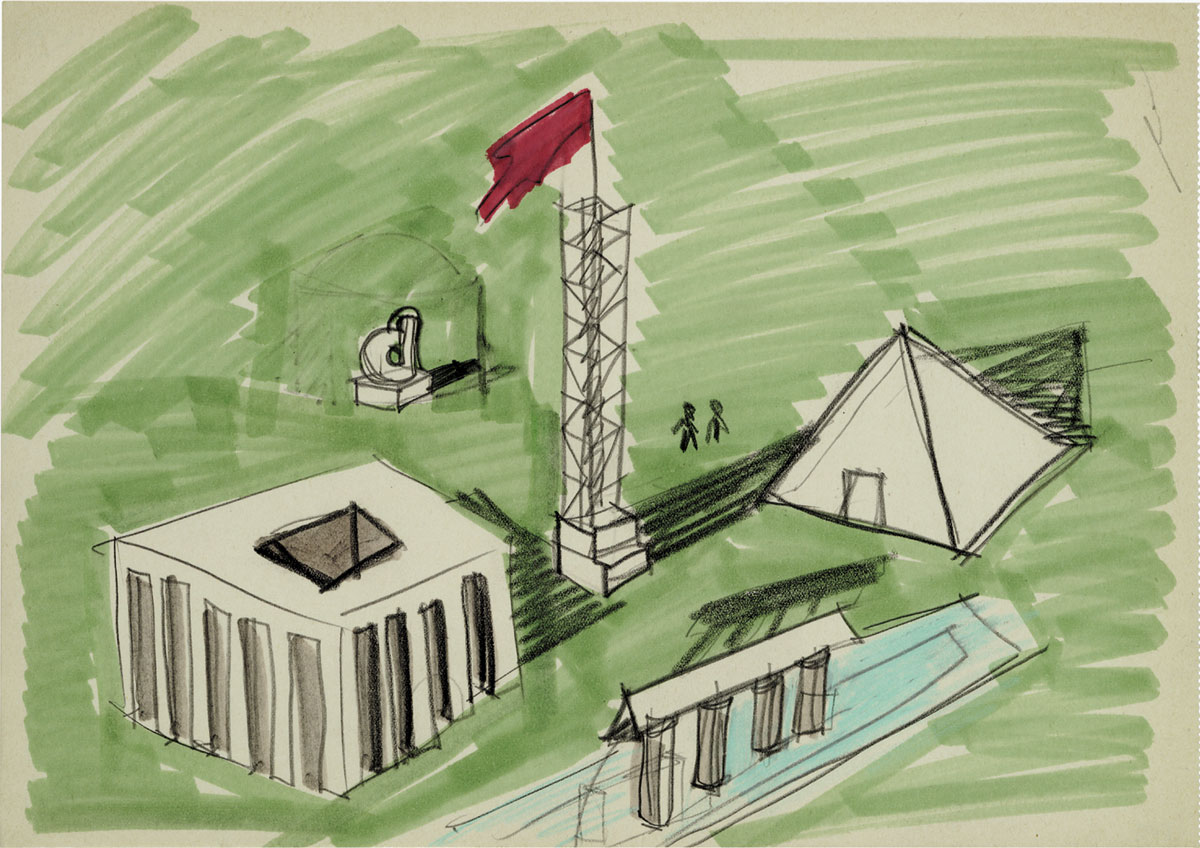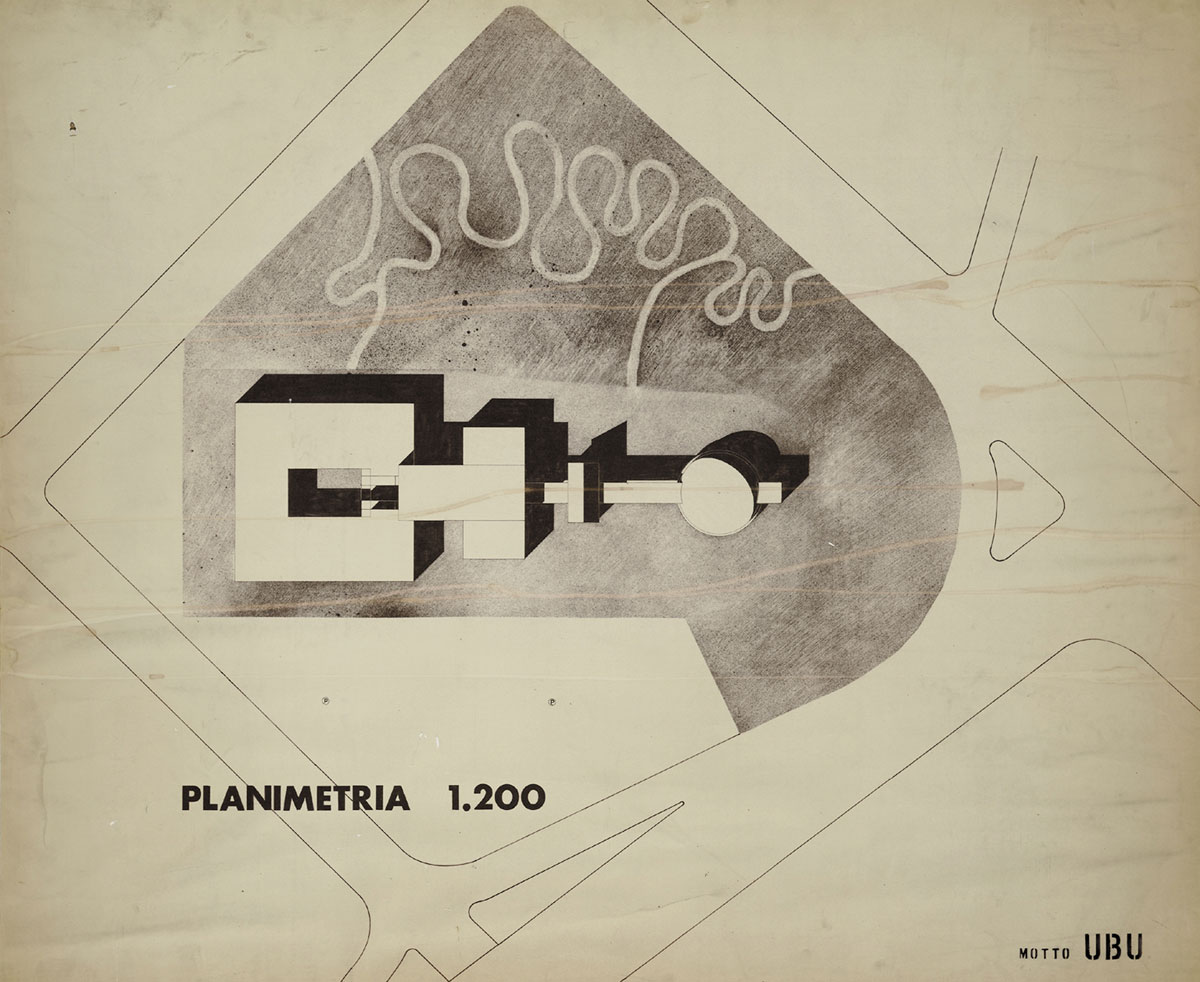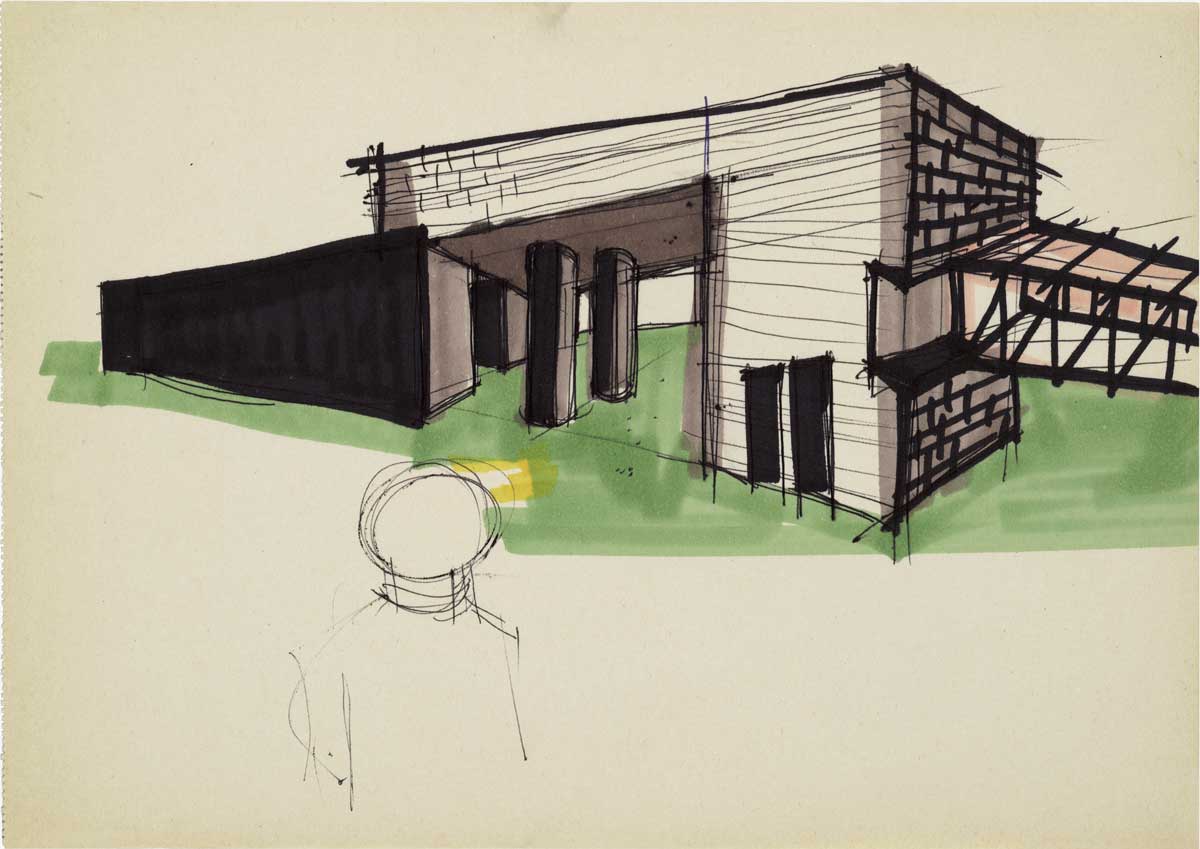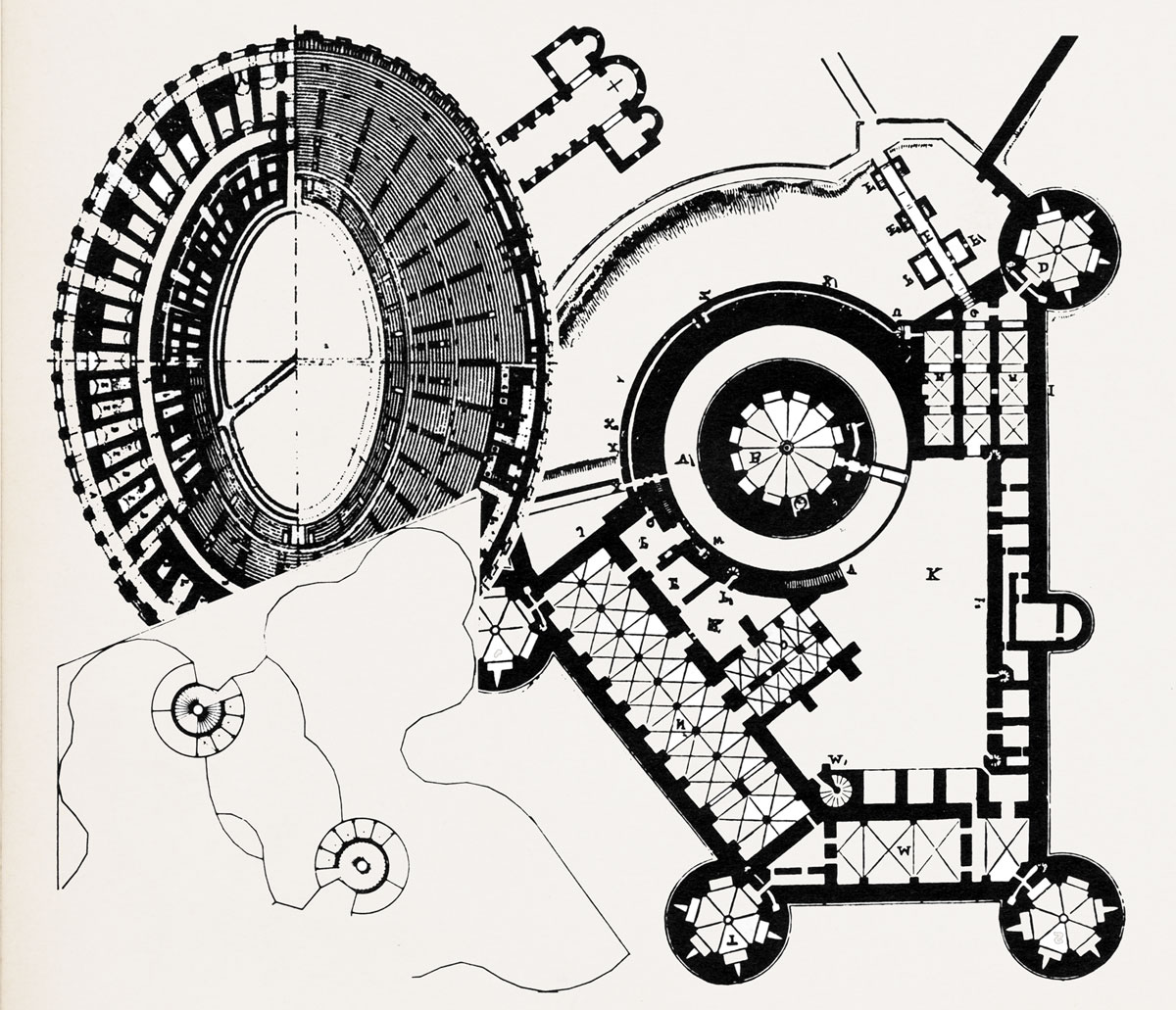Introduction
The work of Aldo Rossi has been the subject of articles, books, and exhibitions since the mid-1960s, when his first book appeared (1966a).1 Still today, historians, theorists, and architects continue to study its various aspects, from his formative years to the concepts discussed in one of his most famous books, L’architettura della città (1966a), to his artistic and industrial design production (e.g., Aureli 2007; Aureli 2016; Baukuh 2012; Celant and Huijts 2015; Fabbrini 2020; Geers and Pančevac 2021; Ghirardo 2019; Lampariello 2017a; Moneo 2004: 101–43; Onaner 2016; Spangaro 2022; Tattara 2019; Vasumi Roveri 2010). This multiplicity of reflections has made it widely known that Rossi’s architecture both belongs to the city and descends from it. Nonetheless, an enigma has persisted regarding Rossi’s architecture of the city. In the application of his theoretical design principles, developed between the 1950s and 1960s, the relationship between his buildings and the various cities for which they were conceived has never been clarified. Opposing points of view on the subject refer to two different scales: that of the project site and that of the city. For some, Rossi’s buildings ‘are tied to their cities in a subtle, though precise, way’ (Bonfanti 1970: 27). For others, they compose a ‘syntactic unity with a city, but not the city in question, the one that should have been studied’ (Savi 1976: 115). Some consider Rossi’s buildings ‘more contextual than one might imagine’ (Ortelli 2016: 251), maintaining that they attempt to ‘respond to the site’ to create ‘harmony with the surrounding landscape’ (Ghirardo 2019: 51, 54). Others hold that none of his buildings ‘really fits its site’ (Geers and Pančevac 2021: 14).
The aim of this article is to lift the veil on the enigmatic relationship between Rossi’s architectures, their sites, and their cities. Taking a novel point of view to arrive at this unveiling, this article investigates the origin of that relationship and discusses its evolution through the 1950s and 1960s. It goes on to make the argument, for the first time in Rossi’s extensive bibliography, that the origin lies in the concept of ambientalismo, which developed in Italy after World War II as a response to the crisis of rationalism. Its proponents advocated an architecture that was rooted in urban centers and took its cues from and confirmed the value of the traditions of the various sites. Rossi’s writings and projects from the 1950s demonstrate that it was this ambientalismo that sparked his quest to explore the inseparable relationship between architecture and the sites on which architecture was built. His later work, however, appears to be a critical reaction to ambientalismo, first looking beyond the project site and later beyond the city in which it was located. Two visions emerged over the course of the 1960s, almost as if to continue the competing discourses that had already manifested themselves before the war (Ricchi 2021). Both aimed for the construction of an architecture capable of representing not the ideal population of Italy’s Fascist regime but the various civilizations that animated the new Italian democracy. Both recognized the tradition of the city as the foundation of architecture. They differed, however, in their identification of what, in that tradition, might represent those civilizations. On the one hand, the architects involved in ambientalismo took as their main point of reference the edilizia — the basic building fabric, characterized by a serial organization and the homogeneity of its parts. These architects intervened in the heart of the city, where, by reinterpreting the generic and anonymous edilizia surrounding the site, they elevated it as emblematic of a collective tradition. Rossi, on the other hand, worked mainly in the peripheries, on sites that lacked any tradition, being either still rural or urbanized by buildings of no architectural value. It was here that Rossi conceived his buildings as monuments, reinterpreting the monuments in the heart of the city, which for him were the expressive permanences of the collective memory.2 His decision to design monuments for the peripheries of cities was born of a desire to give those sites qualities that would be ‘analogous’ to those of the historic city centers. In taking this approach, he disregarded the characteristics of the project site, which instead were promoted by ambientalismo as the generator of architecture, and which would also be the focus of contextualism, which would begin to form in the mid-1960s. In its uprooting and reinterpreting of monuments without ever bending to the contingencies of the site, Rossi’s architecture produced disambientamento (displacement) and decontextualization, though in the beginning it was still possible to identify his attempts to link his architectures to the permanences of the cities to which the peripheral sites belonged. However, towards the mid-1960s, Rossi began to also make references to monuments in distant cities that were part of the same larger territory and which he considered homogeneous in terms of geography, history, hydrography, and economy. Selected, uprooted, and reinterpreted according to Rossi’s autobiographical poetics, the new monuments produced loci capable of evoking their collective history despite having been generated by personal analogies.
With respect to the fundamental concepts of Rossi’s poetics discussed in recent years (Aureli 2016; Geers and Pančevac 2021), this article promotes the monument as key to the interpretation of Rossi’s architecture of the city. Based on an examination of his writings and projects, published and unpublished, and in public and private archives, this article argues that, starting with Rossi’s early reflections on ambientalismo, the monument became a crucial component of a vision that called for destroying the anonymous building fabric and invading the project sites, and later the city itself, with lawns and trees. This article challenges the classic interpretations of Rossi’s work by demonstrating how the city of his vision no longer adhered to the traditional idea of the city. Instead, it became an ‘equivalent urban landscape’ consisting of lawns, trees, and loci that refused the surrounding environment (ambiente) and context because they themselves contained the essence of the city: persistent forms in the lives of human beings, intersections between individuality and community that were capable of guiding the process of urbanization. The first part of this article illustrates the Italian context in the postwar period and the quest to root architecture to its site by taking the cues for its configuration from the anonymous building fabric, the edilizia, of the surrounding environment. It then explains the position taken by Rossi during his formative years with respect to the tradition of the city, his initial hesitation between edilizia and monuments, between site and territory, and his choice of the monuments and sites for the construction of a particular type of ambientalismo. The article continues with an illustration of how he would ‘uproot’ the monuments of historic city centers and displace them in the peripheries. Finally, it argues that Rossi’s reflections culminated with the reinterpretation of the locus as the crystallization of the monuments of a vast territory, to be evoked analogically and in opposition to every surrounding environment and ambientalismo. The discussion on each of the decisive phases of Rossi’s thought is supported by an analysis of one of his projects, chosen as exemplary in its reflection on the inclusion of every new architecture in the various cities for the construction of a ‘new urban landscape’ made up of green surfaces and monumental and analogical loci.
‘Pre-existing Environmental Factors’
Under the impetus of certain Italian architects, an irreversible transformation of the theoretical and cultural foundations of architecture took place in Italy after World War II. Active involvement in Fascist cultural policies had reduced rationalism to an ‘abstract dogmatic mechanism’ (De Carlo 1953–1954). In the inevitable prospect of its ethical and formal re-foundation, the city became the subject of a new study. Founded on either intuitive experiences or historical research, these studies promoted the tradition of the city as the essential reference for the reconstruction of urban centers destroyed by the war. The contours, alignments, textures, materials, and colors of the generic pre-existing building fabric of any given site became the principles for the generation of a new architecture. Because the Fascist regime had sought forms capable of representing its political strategies, they were monumental and even imperial in character. The architects of postwar Italy turned to new references that kept their distance from every rhetoric, in continuity with the legacy of one of the symbols of anti-fascism, Giuseppe Pagano, who died in a concentration camp. Pagano had indicated that the identity of rationalism was to be found in the local traditions of minor architecture (Sabatino 2010). A passionate quest emerged in the postwar period to inject architecture with ‘our own typical imprint’ (Gruppo 7 1926). Far from the previous authoritarian magniloquence, architecture wanted to be democratic in its representation of the ordinary and anonymous history of cities, concretized in a given project site. Thus, among the various architects involved in the reconstruction, Giuseppe Samonà conceived buildings as evocations of ‘atmospheric surroundings’ (Samonà 1949: 93). Franco Albini pursued a way of building which he considered ‘analogical’ to the traditions of the anonymous construction at the sites (AFA 1952–1956), while Mario Ridolfi with Wolfgang Frankl conceived an architecture that was informed by local materials and construction systems. Ignazio Gardella developed projects proportionate to the existing building fabric of each site, and Saverio Muratori prepared a historical analysis of the city as an ‘operative’ support for an architecture that aimed to interpret the local edilizia (Muratori 1959). In their quest to root their buildings to their sites, they all used reinforced concrete skeletons and various types of infill walls. Both were left exposed in order to strip the architecture of any type of covering, in contrast to the monuments to concealment that the Fascist regime had built to represent Mussolini’s policies, thus taking another step towards the ideal of democratizing rationalism.3
The content and orientations of the theoretical and design trends of postwar Italy were summarized in the mid-1950s with the definition of preesistenze ambientali (‘pre-existing environmental factors’)4 by Ernesto Nathan Rogers, a teacher at the Politecnico di Milano, editor-in-chief of Casabella-Continuità, and member of the groups BBPR and CIAM. The anonymous building fabric surrounding the project site became the foundation of the creation of an ambientalismo rooted in the historical continuity of cities and their civilizations, yet capable of expressing meaning that remained valid in the present. In evoking that building fabric, the purpose was to put forward a civil act intended to represent the salient characteristics of its residents, recognizing, in the anonymous tradition of the sites, the history of urban communities. But evoking that building fabric also became an act of urban significance for its construction of continuity with the local tradition, to avoid any alienating urbanization. Preventing stylistic imitations and any form of the picturesque that the study of the surrounding environment had produced in the early 1900s (Giovannoni 1925), Rogers looked to contemporary examples. Alfred Roth’s book on the various expressions of the Modern Movement (1940), together with Frank Lloyd Wright’s recent works in Venice, Le Corbusier’s in Chandigarh, and those by certain Italian architects instead convinced him that it was precisely rationalism that was advancing towards a phase of renewal. Despite its universal principles, rationalism now had to find ‘for every place … the appropriate expression’ (Rogers 1955a: 4). BBPR’s Velasca Tower became the maximum expression of the building tradition of Milan. Rooted in the heart of the city in continuity with its history, it was representative of the Milanese ‘habits’ and ‘customs’ (Rogers 1944) (Fig. 1). At the upper floors, where the apartments are located, its reinforced concrete skeleton took on a branched configuration reminiscent of medieval struts. The cementitious mixture used to cover the skeleton like an eloquent skin was created based on the materials of the ‘pre-existing environmental factors’, thus contributing to recreating the ‘ineffable yet perceptible atmosphere’ (‘Ernesto Rogers’ 1961; Rogers 1957: 312).
BBPR, Velasca Tower, Milan, 1950–1958. From BBPR (1959). © Casabella.
The magazine Casabella-Continuità contributed to making insertion within the ‘pre-existing environmental factors’ the principle by which to reinterpret and produce an architecture rooted in the ‘spirit of tradition’ of the building fabric of the site for which it was conceived (Gruppo 7 1926). The various issues featured photographs and drawings of buildings by Albini, Ridolfi, and Gardella, accompanied by text that emphasized their ‘relationship with the surrounding environment’ (De Carlo 1953–1954; Gentili 1954; Gregotti 1957; Samonà 1958). The essays devoted to the younger generation of architects, from Studio Valle to Vittorio Gregotti, Giorgio Raineri, and Gabetti and Isola, confirmed ambientalismo as the generating principle of the architectural project (Gregotti 1956; Samonà 1955; Semerani 1958).5
The debates, projects, and buildings of the Italian reconstruction culture were decisive in orienting Rossi towards the conception not of a generic and abstract tradition (Durbiano 2000: 77–83; Lampariello 2017a: 40), but specifically of a tradition understood as the ‘relationship between architecture and its civil reflection on the city’ (GRI/ARP/7/82 1959: 3). And yet, beginning in his formative years, Rossi always provided a different point of view with respect to the other prominent Italian architects in identifying that tradition, its geographical delimitation, and its reinterpretation in architecture. In this way he laid the foundations for a personal and poetic vision that was entirely focused on the concept of monument.
Aldo Rossi’s formative years, between edilizia and monuments, between site and territory
The first traces of Rossi’s interest in the tradition of cities and its re-elaboration in architecture are found in his first important essay, written between 1955 and 1956, while he was studying at the Politecnico di Milano (Rossi 1956). Rossi wrote the essay as part of his participation in the communist political culture,6 having understood that the 19th century contained crucial references for the reconstruction of Italy’s national identity after the Fascist period and the war.7 The architecture Rossi had discovered, Milanese neoclassical,8 became for him the concrete example of a reinterpretation that was not generic and bookish but instead based on local tradition and made with local colors, structures, and materials. He explained,
The solidity and audacity of the building techniques, the use of certain colors like yellow plaster and red brick, the composure of the façades, discerned in a careful observation of the structure, all qualities that were already characteristic of ancient Lombard architecture, were understood and studied by Milanese neoclassical architecture. (GRI/ARP/8/109 1955)
Considering the relationship Rossi was building with Rogers during those years, this interpretation should not be surprising. In fact, in 1955, while he was studying neoclassicism, he wrote for Casabella-Continuità9 and attended Rogers’ course, Stylistic and Constructive Characteristics of Monuments, during the period when Rogers was developing his definition of ‘pre-existing environmental factors’ (Rogers 1955b). Before Rossi’s essay was published, he submitted it to Rogers as an exam paper, for which he received a grade of 30 out of 30.10 Nonetheless, Rossi’s interpretation of the tradition of the city was not a slavish imitation of that of Rogers. In his essay on neoclassicism, a clear divergence emerged between how Rossi defined and identified tradition with respect to the approach indicated by Rogers. The ‘ancient architecture’ was an essential reference of Milanese neoclassicism. But rather than limiting it to the Milanese tradition, Rossi opened it to the entire region. The use of the adjective ‘Lombard’ in Rossi’s citation is revealing in this sense. It was a precise indication, though still in nuce, of his reflection on the tradition of an area much larger than the immediate surroundings of a given site, which instead was the focus of ambientalismo. Furthermore, Rossi correlated ‘ancient architecture’ not with the pre-existence of anonymous building fabric but with monumental permanences. Monuments were a ‘testimony to civilization’, an ‘organic expression of a certain order of life’ (GRI/ARP/7/81 1956: 3), a ‘stern commemoration’ and ‘comprehension of human passion’, ‘the highest meaning of civic spirit’, ‘the expression of individual content’, and finally, ‘the paradigm of architectural expression’ and a ‘constituent element’ of the city (Rossi 1955: 66; GRI/ARP/8/109 1955). Every aspect of Rossi’s theoretical vision on the tradition of the city was delineated based on his definition of monument. Its origin can be found in Rogers’ teachings, but once again Rossi took his distance and offered his personal point of view. For Rogers, the ‘monument’ was ‘memory’, ‘warning’, ‘archetype’; it coincided with Rheims Cathedral, Brunelleschi’s cupola, and Palazzo Massimo in Rome, but also with a ‘fisherman’s house’ and a ‘farmhouse’, in a synthesis between fame and anonymity, the outstanding and the ordinary, to be interpreted in the context of Italy’s quest to democratize rationalism (Rogers 1952: 215–16). For Rossi, the monument was instead a permanence that was elevated above the anonymous pre-existing buildings by virtue of its form and size. Because it was recognizable and recognized by the entire citizenry, the monument interrupted the continuity of the building fabric to constitute an identity-making form. In his notes on neoclassicism, Rossi identified monuments precisely as municipal buildings, hospitals, and universities, while ‘temples and forums’ were not included (GRI/ARP/8/109 1955). There was no room for monumental magniloquence in Rossi’s reflections. Instead, he emphasized how their neoclassical reinterpretation had been conducted to make them less ‘stately’, and even ‘domestic’ (GRI/ARP/8/109 1955). Rossi’s adherence to communism, which was particularly strong in the mid-1950s, before the events in Poznań and Budapest, pushed him towards a political vision of monuments that saw them as public buildings at the service of the community. Rossi seemed to be contrasting the anonymity of the building fabric with the powerful identity of public buildings. He seemed to be contrasting the individuality of the constructions that constituted the building fabric, each with its diversified shape, height, and plan, with a unitary, well-defined image of the community into which each individuality merged and with which it identified. And finally, he seemed to be summarizing any varied, uncontrolled, and amorphous construction of the building fabric into a single form. Thus, Rossi’s interest in monuments, on which the critics have sometimes dwelt (Savi 1976; Vasumi Roveri 2010), cannot be separated from his political affiliation. Neither can it be separated from his vision of an absolutely necessary fusion between collective history and individual history, which he considered possible only by means of public permanences. A photograph taken by Rossi during a trip to Moscow in 1954, in which the monuments of the Red Square stand out in the distance against the sky, framed so that they appear only as silhouettes contrasting with silhouettes of individuals, became the manifesto of the theoretical intentions of the young student (Fig. 2). It was the unique point of view of the photograph, practically at ground level, that gave the monuments a human scale, in this way making it plain that their essence was to be of service to the community and to represent it. The paved surface instead created the necessary distance for observing the monuments, as confirmed by Rossi in his contemporaneous student project for the restoration of a monument in Lomello (Pavia). He proposed lawns and trees to isolate the monument from the edilizia, elevating it to the status of symbol of the community: ‘The monument will be surrounded on the north and west sides by a large and beautiful garden with tall trees to provide an evocative frame for the ancient red of the bricks and the severe mass of the building’ (GRI/ARP/7/81 1956).
Rossi’s essay on neoclassicism marked the beginning of an operation of ‘revisionism’ (GRI/ARP/1/1 1954) of architecture that he undertook beginning in 1956. The reinterpretation of the tradition of the city was the principle through which he reexamined projects and buildings, both Italian and foreign, both contemporary and from the past. The insights contained in his essay on neoclassicism regarding the delimitation and identification of that tradition do not seem thoroughly developed. In fact, his discussion of tradition was limited to the surroundings of the project site. Its various denominations showed, on the one hand, Rogers’ influence (‘surrounding environment’, ‘the reality of history’, ‘historic surroundings’), and on the other hand, a correspondence between the tradition of the city and the edilizia of the surrounding environment (‘housing tradition’, ‘fabric’, ‘building fabric’, ‘building context’). Monuments were not mentioned in Rossi’s essay. One gets the impression that he had not yet developed his interpretation of monuments to the point that he was ready to discuss them in the pages of Casabella-Continuità. Bringing the concept of ‘monument’ back to the center of Italian debate after World War II could have become problematic, and this fact should not be underestimated. This is what happened in the 1970s, when the monument was seen as a vehicle of magniloquence and rhetoric comparable to that of the Fascist regime (Melograni 1971: 7). Thus, in line with the contemporary Italian interest in the tradition of the minor architecture of the various sites, Rossi considered Ridolfi’s buildings in Terni to be expressions of the ‘original building fabric’ of the heart of the city, while those in Cerignola were the ‘latest stratification of a housing tradition that originated in the Romanesque period’ (GRI/ARP/9/151 1955: 55). Regarding the Mole Antonelliana, Rossi observed how ‘the plan of the building originated directly from an interpretation of the historic fabric of Turin’ (GRI/ARP/8/105 1957: 4). He pointed out that every work by Adolf Loos ‘was formed in the place that was assigned to it, poetically interpreting the surrounding environment’, and that the ‘link with the historic surroundings’ of the building in Michaelerplatz was ‘the decisive characteristic that inspired the project’ (GRI/ARP/7/73 1959: 11, 20). For Rossi, Auguste Perret’s building on Rue Franklin represented ‘the best model of a common building context’ (GRI/ARP/7/73 1959: 19). In Peter Behrens’ factories, Rossi saw ‘a careful link with the surrounding environment’ (GRI/ARP/8/115 1960: 2) and in the buildings by Oswald Mathias Ungers he observed an ‘attempt to tie themselves to the reality of those who live in that place and to the reality of its history’ (GRI/ARP/9/142 1960).
More than any of his writings, one of Rossi’s university projects from 1956 clarifies his theoretical position on the tradition of the city, which had seemed poised between the generic edilizia and the monuments, between the scale of the site and a larger scale. Consisting of the design of an office building for his Composition I class, the project has thus far been almost completely ignored by critics, with a few exceptions (Ghirardo 2019: 205; Lampariello 2017a: 69).11 The site of the project is unknown, and the plan and façade do not include any adjacent fabric (Figs. 3, 4). Tradition makes its appearance in just one of the drawings, which is sketched by hand (Fig. 5). In this drawing, the building shown adjacent to Rossi’s is no anonymous edifice but rather one of the most ‘constituent’ and significant parts of Milan: Ca’ Granda by Filarete. Rossi deemed this monument, more than others, to be a ‘stern commemoration of human passions’, as it was originally conceived as a hospital, at the service of the community. Its permanence was so strong that it survived the bombs of World War II. In his decision to confront, on the site of the project, this former hospital, which had been built out of scale with respect to the pre-existing fabric to accommodate the entire citizenry of Milan, and which was later transformed into a university, Rossi’s annotations on Milanese neoclassicism seem to take shape in his drawing. His office building, drawn as a continuation of Ca’ Granda, in the same plane and with analogous floor heights, took the form of a wall articulated with a reinforced concrete skeleton in relief over the brick infill, the same construction technique used for the residential buildings realized by BBPR in Milan at the end of the 1940s. Rossi determined the length of the bays based on those of Ca’ Granda, instead of exploiting the structural potential of reinforced concrete, which would have permitted greater spans and thus savings in cost and material. The configuration of the skeleton was calibrated to resonate with the arches of Ca’ Granda, in this way elevating reinforced concrete to the status of a material capable of expressing continuity with Filarete’s stone skeleton, therefore revealing its nature as artificial stone. In this sense, the bracketed joints between the pillars and beams designed by Rossi can be seen as an attempt to transform the reinforced concrete skeleton into an abstract order that dialogued with the one by Filarete. Certain variations in his drawing of the façade confirm that Rossi focused his interests on the configuration of the skeleton. Sometimes the beams were eliminated to impose a rhythm of pillars only, each with a tapered profile, similar to the pillars of Ridolfi’s residential complex on Viale Etiopia (Rome) or Albini’s INA building (Parma). However, the brick infill was a constant, as it constituted a declaration of belonging to the Milanese tradition. In fact, those bricks had been adopted over the course of the 1950s as the typical construction technique of Milan, in the wake of the 19th-century works by Camillo Boito and those by Giovanni Muzio from the 1920s and 1930s.12 But the choice of Ca’ Granda marked a desire to go beyond the 19th- and 20th-century building tradition to arrive at its monumental origin, by making reference to an architecture that possessed urban significance in its existence as a conceptual alternative to the center of Milan. ‘The Ca’ Granda is above all the house that was built for everyone’, wrote Rossi (1981: 58).13 While the façade of the building was a declaration of intent of a young student who integrated his project into the site in accordance with his teachers’ ambientalismo, the choice of Ca’ Granda indicated a different trajectory. From then on, any building by Rossi, whatever its intended use, would stand metaphorically alongside the monuments, absorbing the essence of their urban and collective condensation.
Two people appear in the sketch, representing the individuals who make up the communities that ‘populate and animate cities’ (Ghirado 2019: 205). However, their presence also reveals other decisive aspects of Rossi’s architecture. One of the figures, in the background, standing between two pillars at the ground level, suggests the existence of a portico, a natural continuation of that of Ca’ Granda, which served as a meeting place for the foundation of a new community after the years of the Fascist regime and war. The other, in the foreground and shown from behind, observes the office building that has been turned into a monument. Destined to become recurrent in Rossi’s work, this figure is the symbol of one of the foundations of his poetics: observation.14 This human being, and therefore also Rossi, observes architectures and cities from afar, from a perspective that is broad but nonetheless always delimited by a physical and temporal frame that separates and encloses, within a single unit, an individual future projected into the community. That act of observation allowed him to identify, by form and dimension, according to a logical operation, the parts of the city that emerged. That act of observation contained within it the recognition of the history of the community, and thus the identification between individual and architecture. And it was from that act of observation that Rossi derived the principles of an invention that freed itself of logic, to instead rely upon the imagination. In his project for the office building, the role of imagination was still limited to just a few structural details. But it would become one of the fundamental components by which he would indicate to contemporary architectural culture a different direction with respect to the one that had been delineated by ambientalismo.
Monuments Uprooted and Displaced in ‘No Man’s Lands’
Of Rossi’s production, his student project for an office building has taken on a new value in light of the correspondences interwoven with the works of his teachers and with his definition of monument. The insights contained in that project and in some of Rossi’s writings during his formative years had already become clear at the beginning of the 1960s, laying the groundwork for what aspired to become a theory. In 1961, in an article in Casabella-Continuità, Rossi railed against any attempt at coherent insertion within the anonymous edilizia of the surrounding environment (Rossi, Semerani, and Tintori 1961: 30). The choice made by the Italian postwar culture to make edilizia its point of reference became, in his eyes, the product of a ‘moralistic state of mind’. Despite the admirable objective of restoring voice and dignity to the communities forgotten by fascism, according to Rossi, that ‘state of mind’ was focused only on intangible ‘atmospheres’ and had done nothing but reproduce the ‘age-old misery of our people’ (Rossi 1961: 24). His criticism did not stop at the references to the anonymous edilizia, but instead went on to attack the conceptual foundation of ambientalismo: that of rooting architecture in the tradition of the site. Rossi could not fail to notice that the field of action of the Italian architects of the early 1960s was no longer the heart of the city.15 The sites of the new architecture were not even the historic peripheries because, in its incessant process of urbanization, the city had by then invaded the industrial areas and surrounding countryside, taking on the dimensions of territory (Piccinato, Quilici, and Tafuri 1962). The sites of the new architecture were ‘no man’s lands’ that lacked any form of tradition, and in light of the absence of that tradition, the project site could no longer have any value. The question that tacitly ran through Rossi’s writings and projects in the early 1960s took on the characteristics of an operative foundation: what were the methods, the tools, and the forms to be adopted to be able to call these sites city and to give them a quality of life and level of interaction analogous to those of the city centers and consolidated peripheries? Rossi would look for and find his answer in the monuments of the historic city, ‘testimonies to civilization’, and to the collective consciousness, as only they were capable of resisting and establishing themselves on the new urban scale. The goal of bringing reinterpretations of the historic cities’ permanences to those ‘no man’s lands’ would also create ‘testimonies to civilization’ where such testimonies had not previously existed. By offering to civilization forms of urban life with which to identify, architectures could be built that aimed to become permanences without the necessary time for the birth of a monument. At the same time, uprooting the permanences of historic cities from their surrounding environments and reinterpreting them in other places without ever bending to the characteristics of the site meant literally displacing those monuments: ‘The new city must be born on the old … the ancient part of the city must be understood as its monuments or the monumental urban complexes that belong to cultured architecture … Any other polemic about the surrounding environment, interesting as it may be, is in itself sterile, because it is neither possible nor worthwhile to preserve that which belongs to an atmosphere, to a situation, to events that cannot be translated into an experience of rational culture’ (FAR 1962).
Overcoming the ambiente (surrounding environment) in its original Latin definition of ambiens, referring to the air — the atmospheres evoked by Samonà and Rogers — was achieved through the most resilient works that exist in cities (MAXXI/AR-ADSC/01 1962). Rossi’s study of the structure of Milan, undertaken at the beginning of the 1960s, revealed to him the decisive role of monuments (MAXXI/AR-ADSC/01 1964). But there is no escaping the impression that the war also continued to have an influence on him. The devastation and bombings left indelible marks on his quest for parts capable of standing up to time and adverse events. This led to his discovery that those parts were the ‘few and rigid objects’ (Tentori 1963: 268), the value of which went beyond their being permanence: they accelerated the evolutionary process of the city, generating transformations and constructions. Free of any type of rhetoric, the monuments determined and controlled the development of the city and of the territory. In Rossi’s vision, therefore, the intellectual origin of monuments overrode the spontaneous character of anonymous edilizia; the permanence of monuments endured over the transient essence of edilizia; the active role of monuments in orienting urbanization replaced the passive role of edilizia in the evolution of the city.
It might seem surprising that Rossi, given his communist affiliation, chose to refer to what he himself defined as ‘cultured’ architecture. Keeping his distance from any ‘moralistic state of mind’, he did not look to an ideal, self-styled working-class population but rather to the values that every era crystallizes through political action, the only kind of action capable of ensuring the construction of architecture (Rossi 1956: 481). A precise interpretation had begun to emerge that aligned with a well-known observation on the part of Loos, according to whom ‘only a very small part of architecture belongs to art: the tomb and the monument’ (Rossi 1959: 7). What interested Rossi was the ‘rational culture’ to which only monuments can contribute, by virtue of their being transmissible and collective, and by which they produce a particular type of rationalism imprinted with the civic meanings of the permanences of the heart of the city. Without nostalgia, Rossi made use of those monuments to build an architecture that aspired to be understood and recognized by every individual. From this perspective, Rossi’s statement makes it clear that ‘it is neither possible nor advantageous to preserve what belongs to an atmosphere’. For Rossi, the diradamento, the thinning out of the urban fabric, that he proposed in his student project for the restoration of a monument became, at the beginning of the 1960s, a theoretical principle that partially originated in the debates of the 1920s and 1930s, when Le Corbusier had proposed demolishing certain parts of the center of Paris in order to isolate its monuments (Le Corbusier 1925a); when Wright had suggested ‘eliminating’ the ‘less significant parts’ of the city and ‘preserving the best of it’ (Wright 1939); and when the Athens Charter declared that ‘the whole of the past is not, by definition, entitled to last forever; it is advisable to choose wisely that which must be respected’ (Le Corbusier 1957: 88). And just as in the beginning of the century, in Rossi’s vision this thinning out was accompanied by an invasion of green. Its origin, however, had nothing to do with urban renewal for health and hygiene reasons but rather with the construction of a theatrical scenography for civic purposes.
Rossi staged his first act of uprooting and displacing a monument onto a green surface with the competition project he prepared in 1962, together with Luca Meda and Gianugo Polesello, for a centro direzionale (business center) in Turin, to be located in its periphery (Fig. 6). The project called for a lawn that extended across the entire project site, scraping away the pre-existing buildings. The green surface created distance between the business center and the ‘atmospheric surroundings’, to produce a ‘clear-cut differentiation’ (FAR 1962). The trees, arranged along the borders, delimited the lawn to create a new ‘frame’ like the one Rossi had imagined in his student project for the restoration of a monument, but this time devoid of ‘evocative’ traits. The trees isolated the site from the surrounding environment and framed it, defining a screen which, like the lawn, would cancel the building fabric surrounding the site by hiding it behind their foliage. But another poetic image found its way into the project, symbolically extending the lawn beyond the trees and spreading it throughout the city and the territory. The fog of the Po Valley became the expedient for hiding all of the edilizia of Turin,16 marking a first step, though still controlled by narrative instruments, towards Rossi’s proclamation in 1968 calling for the destruction of the entire urban fabric. And thus, as with the restoration project, Rossi used trees, lawns, and now fog to build the backdrop for a pièce de théâtre in Turin in which monuments were the only actors, plunging the city into silence and a metaphysical void.
On this stage, extended on the scale of the city, Rossi, Meda, and Polesello conceived the design of their monument, starting from an ‘ancient part’ of the center of Turin, which they considered permanent and life-generating: the orthogonal grid of streets which by then had become fixed in Rossi’s vision, fossilizations of the past and at the same time dynamic in their ability to accept and promote constant change. Rossi’s reflection was of the utmost importance in terms of the project’s development, because the concept of permanence was no longer limited to public buildings. It had been opened up to any other vital, persistent, and collective urban artifact. Rossi’s creative intentions were clearly expressed by an ideogrammatic drawing, with a square-mesh grid in black lines, enclosed by a frame and with the letters ‘CD’ (centro direzionale) superimposed on it (Fig. 7).17 The frame enclosing the grid pattern was crucial to understanding the operation that was carried out in the project, because the grid did not continue on across the site to create a new fabric imitating the old. A single module of the grid was used to create a square prism around a courtyard, a form that closed in on itself. Rossi’s defining statement, that ‘the block becomes the form of the architecture’ (Rossi 1971), clearly demonstrates the logic upon which they based their proposal for a business center. But the motto project was even more explicit in defining the operation and in choosing the permanence of the old city, uprooting it and displacing it in the periphery. The motto ‘Locomotiva 2’, with its Latin etymology of locus (place) and motivus (motion) (Gargiani 2020b: 28), reveals the essence of the business center as a locus that had been condensed into a collective monument. Uprooted and displaced to build a new city, the monument was indifferent to the shapes of the blocks and to the alignments of pre-existing edilizia, which by then had been erased by lawns, trees, and fog. Thus, the placement of the business center could only be determined by geometric principles: it was situated in a barycentric position to maintain equal distances to the edges of the site while leaving open space at the north and south ends. To make the lawn as large as possible, the project did not include the apartments and hotels that had been stipulated in the competition program.
The form devised by Rossi, Meda, and Polesello went beyond the replication of the block shape, thanks to an act of imagination that gave it a metaphorical value. They enlarged the business center to the ‘exceptional size’ of 340 × 340 meters (Rossi 1972a: 80). The reasons for the change of scale of the historic permanence should not be sought only in the expansion of the city during the economic recovery (Lampariello 2014: 111; Lampariello 2021: 156) or in the megastructures that were being produced in those years (Aureli 2016: 110), to which Rossi responded with an identity-making, delimited, and well-defined form. The business center is a metaphor of the city in its configuration of a closed frame around a square courtyard, like the frames enclosing a circle of Louis Kahn’s Philadelphia towers, ‘large walls that surround the medieval cities’ (‘Il piano regolatore di Philadelphia’ 1962: 7).18 Both the road circulation and the building’s structural system participated in the urban metaphor, both of which were conceived to elevate the frame devised by Rossi, Meda, and Polesello to the status of a ‘new historic city center’ for the territory of Turin (FAR 1962). The roadway consisted of viaducts that passed through the frame to become the decumanus maximus of the new urban entity, which not by chance was included in the infrastructure foreseen in the town planning scheme of Turin: the ‘asse attrezzato’ (arterial road with tertiary development along its path) that was meant to cross the Region of Piemonte from north to south, linking its various parts (Fig. 8). The structure lost its humble connotations as a postwar skeleton when its vertical supports were reduced to just 12 hollow cylindrical pillars, each 10 meters in diameter. Beyond any reflection on economics, anonymity, or democratization, and with no interest in technical details, thicknesses, or the composition of materials, the structure aspired to ensure a longue durée by the sheer force of its monumental form. The cylinders, freestanding and visible for the first 30 meters, generated a grandiose portico order. At the upper floors they were enclosed by a curtain wall. Because it was glazed and because it protected the trees and other vegetation in the enormous courtyard, the curtain wall transformed the business center into a ‘greenhouse’ (FAR 1962). It would have created a natural landscape in the heart of the ‘new city’ from which only monumental forms emerged — a dome and a platform. This greenhouse would have become the scenographic backdrop framing another colossal monument with which Rossi’s architecture aimed to resonate after Ca’ Granda: the Mole Antonelliana.19 But this time his monument did not replicate the height, the orders, or the material of the historic permanence, because its identity-making form was free from styles. The curtain wall was drawn as a continuous, abstract surface, devoid of any lines indicating windows or glazing, the materialization of a ‘non material’ (Rossi 1972b), necessary for denying any involvement with the surrounding environment and to build an urban metaphor (Fig. 9). Contrary to what was previously understood (Lampariello 2017a: 135), Rossi did not want its reflections to cause the form to dissolve behind the image of the building fabric of the surrounding environment, in order to avoid transforming the façade into a mirror of the ‘misery’ all around it. But neither did he want the building’s transparency to make a spectacle out of the work taking place in the offices. The curtain wall of the greenhouse diffused the ‘glimmer’ of the business center, making it identifiable as a new city that ‘converges and pulsates’ (FAR 1962). The permanence of the ancient city, uprooted, amplified, re-elaborated, and displaced, became a screen, this time luminous, or a lighthouse that attracted and permitted the vision, directing the architecture of the future within a sea of anonymous, formless building fabric.20
Locus and analogy for ‘geographical transpositions’
In Rossi’s continuous process of subjecting his reflections to clarification and further investigation, the ‘few and rigid objects’ remained fixed, though from time to time he gave them new definitions that offered a glimpse into the evolution of his thinking, despite what he himself wrote (Tentori 1963: 269). In the mid-1960s, locus was the definition Rossi provided for the permanence. ‘Persistence’, political, economic, and civil history fossilized in the forms, a collective memory; the locus was that which contributed to the ‘individuality’ of architecture.21 It had nothing to do with ‘the relationship between urban artifacts and space’ (Lampariello 2017a: 174), nor with the building fabric that represented the most transient and ‘pathological’ parts of the city, those ‘residential zones’ (GRI/ARP/2/34 1966–1967) whose preservation interrupted every evolution, transforming the city into an ‘embalmed corpse’ (GRI/ARP/6/69 1964). What were previously ‘pre-existing environmental factors’ became, in Rossi’s research, clearly identified as ‘vital permanences’. ‘Only when it [the architecture] is built as a monument does it constitute a locus’, he explained (Rossi 1966b: 17). Thus, the locus was not just a response to the new dimension of the city by constructing fixed points in its continuous urbanization (Aureli 2016: 106). The definition of locus contained the potential of the monument to go beyond the scale of the building and the street to become a more generic seat of events, old and new, in order to inhabit a single and closed artifact. It was a frame which, in its function of protecting and separating, wanted to arrive at the origin of architecture, thereby revealing, finally, the ultimate objective of Rossi’s research: the construction of an architecture capable of being city without the building fabric of the surrounding environment, which not surprisingly was never again shown in Rossi’s project drawings, as it had been for his office building. Nor was the surrounding fabric shown in his models, and sometimes it was even erased from the photographs of his built works.22 At most, perimeter lines might appear in his plan drawings of the block of the project and the adjacent roads, but without their exercising any influence in determining the entrances, which were either multiplied along the various sides of the buildings or not represented at all. Rossi isolated each monument on its site to create an autonomous form, or locus solus (Rossi 1966b). A new green surface was extended all around, going beyond the project site to assume unprecedented urban forms. In response to his question, ‘What to do with the old city?’ he responded, ‘Accentuate the process of destruction of the surrounding environment so that the monuments can participate directly in the construction of the modern city’ (1968a: 43; Lampariello 2021: 177). And for the specific case of Venice, he added that ‘we prefer to imagine the city once again consolidated in its monuments in a landscape of grass and water’ (1972c: 690). The green is the result of a conceptual deflagration produced by a monumental locus that acts like a warlike device in its destruction of the urban fabric, in its shattering of every continuity of the pre-existing environmental factors, in its producing all around nothing but open surfaces for observation and identification — ‘ordigno formale’ (formal ordnance) is another of his definitions (Rossi 1969a: 10). The strength of the monumental locus in terms of concept, content, and form reached such levels in Rossi’s reflections that it annihilated the traditional image of the city — to which he had devoted years of research, culminating in the publication of L’Architettura della città — because one of its parts had been eliminated: the edilizia. In its place, a ‘smooth and limitless’ surface became the support for a combination of monuments with the value of locus. The fact that the green and the loci were produced by an ordigno formale that destroyed the edilizia makes those monuments, also in Rossi’s words, not so much generic ‘fragments’ as true ‘shards’ of human artifacts (Rossi 1970). Rossi seemed sufficiently aware of the subversive character of his vision that he no longer used the term ‘city’, substituting it with ‘equivalent urban landscape’ (Rossi 1968a: 43) and ‘new urban landscape’ (Rossi 1969a: 14). The term ‘landscape’ came from the work of one of the French geographers Rossi studied in the first half of the 1960s, Georges Chabot (Rossi 1964a: 16). But the adjectives ‘new’ and ‘equivalent’ provide a glimpse of the vision of an entity that was no longer city, though it continued to evoke its essence, as Rossi had discovered in the fictitious Venetian scene of Canaletto’s capriccio with Palladian buildings. The origin of that vision can be found in the ancient monuments represented by Piranesi in his Roman scenes (Rossi 1969a: 10) which are without edilizia and immersed in a field that has been returned to civilization and to nature.23 Rossi had re-experienced these allusions just after the end of the war, when, during his return to Milan from the Lombard countryside, he discovered a new urban landscape consisting of ‘few and rigid objects’ and a nature that had been set free again. Green surrounded the monuments, it ‘grows inside’ and on top, commented Rossi (Rossi 1969a: 14), revealing the essence of the concept of locus as ‘empty shell’ (Benjamin 1950) or ‘moule creux’ (Focillon 1934: 8).24 A permanent frame that welcomed different functions from time to time, it was so powerful that even when it was invaded by vegetation, offering a glimpse of death, transforming it into a tomb, it returned to life; it protected the vegetation, becoming a new ideal greenhouse, materialized in the symbol that became the ultimate description of the Earth inhabited and transformed by human beings. ‘The monument becomes geography’, wrote Rossi (1967: 20), finally making it explicit that his locus — an a-historic frame, returned to, and then attacking, nature and time, leaving only a skeleton — was detached from any monumentalism. It became instead the emblem of a ‘desecration’ of permanences (Rossi 1976) in its having been moved, reinterpreted, and, finally, reduced to a form with the value of a ‘shell’. Thus it becomes clear why, at the end of the 1960s, Rossi began to surround some of his loci with trees, grass, and cows,25 and, at the beginning of the 1980s, produced a series of drawings with historic permanences and some of his other loci and green spaces, meaningfully titled Hommage a Claude Lorrain (Fig. 10): the monuments and the nature of the new urban landscape that wanted to be neither a new Arcadia nor ‘silent museums’ to be visited ‘every so often’ (Tafuri 1968: 67). Those monuments were, potentially, condensers of life and turmoil, of human and mechanical motion. Considering Rossi’s notes on Piranesi’s views and his later interest in Lorrain, the genealogy of his thought must also include his reflections on Diderot and Boullée regarding ‘urban monuments open to the depth of the forest’ (Rossi 1967: 24). And, though never cited by Rossi, it should also include Le Corbusier’s drawing with the Antiquae Urbis Romae by Pirro Ligorio standing out against the vegetation and presented as a prototype of the modern city (Le Corbusier 1925b). However, Rossi’s ordigno formale and its lawn also reveal an affinity with what was being produced in Italy in that same period by a faction that was often seen as opposite to Rossi, so-called Radical Architecture, and more precisely an affinity with Superstudio’s Monumento Continuo:26 the Monumento Continuo is the quintessence of perpetuity, a shell that appeared after an atomic explosion destroyed the shapeless 19th- and 20th-century edilizia to contain a new form of city immersed in nature (Gargiani and Lampariello 2019). The concept of the monumental locus ran through various factions in Italy. During the period of economic recovery it became the foundation of new forms of rationalism that were distinct in their differing objectives and systems of cultural references. It also became the ‘glimmer’ of a new generation of urban landscapes that would find other formulations in Carlo Aymonino’s project for Roma Est, in David Griffin and Hans Kollhoff’s collage for City of Composite Presence, or in Ungers’ Green Archipelago.
If the monument destroyed the building fabric of the surrounding environment, substituting it with a locus on a green surface, a new concept laid the theoretical foundations for the destruction of ambientalismo. That new concept presented itself as an alternative to the mechanical evocation of the project site and of the heart of a specific city — the analogy that Rossi developed beginning in 1966 (not 1969, as has long been believed by scholars) (1966c: 74). The traces of that concept in Rossi’s writings three years before his disquisition27 revealed Rossi’s typical manner of proceeding, first by intuition, followed by a period of in-depth research — which in this case also involved the figure of the greenhouse.28 Beyond any discussion on the references used by Rossi for the definition of the analogy (Savi 1976: 112–14), the aim here is to highlight its origin as a compositional process that rose from the ashes of ambientalismo. The idea of architecture that was being delineated denied any form of continuity with the site’s pre-existences, whether physical or temporal. Thus it was in opposition to the architecture of Albini, who had also evoked the concept of analogy, and also in opposition to that contextualism that established itself in 1965 and which was proposed as a topic of international debate in 1971. Rossi selected his references without following a chronological order.29 Starting from a vast territory, he would identify common traits in order to continue representing its collectivity. Rossi’s trajectory was indicated by Milanese neoclassicism, with its interest in the architecture of Lombardy, and by urban studies on the territorial scale that had been conducted in Italy since the late 1950s.30 But it was his own urban vision that allowed him to transcend the site and the urban center in order to ‘make the monuments participate directly in the construction of the modern city’. In the ‘new landscape’ there were no more sites, city centers, or peripheries, only monumental and analogical loci. They condensed the essence of the city into closed forms distributed over a lawn, to be selected and reinterpreted according to an act that no longer consisted in uprooting and disambientamento (displacement), because, in Rossi’s vision, the surrounding environment and the context no longer existed. ‘The idea of the Palladian locus has cut the site of the villa off from its context’, Rossi would write (1990: 44),31 finding an unprecedented reference for his conception of locus in the architect who had declared that ‘the city is like a large house’ and ‘the house is like a small city’ (Palladio 1570: II, 46). If one were to use the words of the 1971 manifesto on contextualism, Rossi’s urban landscape was made of neither ‘solids in voids’ nor ‘voids in solids’ (Schumacher 1971: 84),32 but of ‘moule creux’ in a void. In that landscape, the cavity and the void have the dignity of existence thanks only to the presence of the ‘moule’. In this sense, it is worth noting that in the plan of the only project situated in a city center that he designed in the 1960s (the Pilotta Theater, in Parma), Rossi inked in black only certain ‘figures’, the monuments, while he left the edilizia in white so that it became ‘ground’ (CCA AP142.S1.D12.P4.1). These black ‘figures’ were only some of the ones Rossi studied for his project for the theater in Parma. There were also other ‘figures’, as he had the opportunity to explain, that crossed over the boundaries of the historic center and periphery of Parma, that belonged to its geographical region, and that built a personal territory consisting of a generic ‘ground’ against which the loci soli stood out like so many islands, isolated and closed in on themselves: the theaters of Sabbioneta and Mantua (Rossi 1966b). Just as with his project for the business center, once again it was Rossi who explained the compositional process underlying his creation of monumental and analogical ‘moule creux’ by providing his definition of ‘geographical transposition’ (1969a: 8).33 In this transposition, his imagination pushed beyond the collective history to accommodate impulses from another history that was instead autobiographical and mnemonic.34 Thus the construction of the locus took place through a combination of monumental references that had been selected, transposed, and transfigured by means of memory and allusions, without seeking any kind of dialogue with the context. They were superimposed over the civic memory, the property surveys, and the cadastral documents, in a combination of individual and collective, of imagination and science, that became the foundation of Rossi’s work: ‘The places. But maybe the places are just ourselves’ (Rossi 1989).
The projects Rossi prepared in the second half of the 1960s for the peripheries of Milan and Florence were ‘geographical transpositions’ for the construction of monumental and analogical loci in the ‘new urban landscape’: the Gallaratese social housing block in the periphery of Milan, designed between 1967 and 1969, with construction completed in 1973, and the town hall of Scandicci, designed in 1968 together with Massimo Fortis and Massimo Scolari. The Gallaratese was conceived to transform edilizia into permanence. In light of Rossi’s reflections on the analogy, the act of imagination aimed at making architecture a metaphor took on the characteristics of a compositional process based on a theoretical principle. Here he applied it to making the building a ‘street’ endowed with a new and ‘exceptional size’, in order to take on the scale of the territory and to traverse another ‘no man’s land’ in the role of a signifying form (Rossi 1974a: 36). ‘The street is a solid geometrical area, a sort of parallelepiped with sharp corners’, Rossi had discovered in the first half of the 1960s (Rossi 1964b: 98). In its existence as a grandiose street, the Gallaratese even ended up invoking one of the most famous examples of a highway transfigured into building, already conceived at the territorial scale to combine street and architecture, cities and monuments: the Plan Obus. But the Gallaratese did not respond to the topography of the site, it did not blend in with the still-rural landscape, it did not want to become an echo of its natural surroundings. It ran straight and indifferent, in the position Aymonino had indicated, even indifferent to Aymonino’s adjacent buildings (Figs. 11, 12). And it rejected any hint of automobile glorification, welcoming only the motion of human beings and offering them a new ‘moule creux’ for the construction of a community. Thus, in its configuration as a long slab with a portico made rhythmic by a skeleton surmounted by regular openings, it reveals its true analogous essence, which had always remained secret until now, under the cover of its ‘exalted rationalism’ (Lampariello 2017a: 240–55): the Gallaratese is one of the wings of the Ca’ Granda, transposed and transfigured to the periphery in order to build, on its own, the ‘new city’. That wing, the same one Rossi had confronted in his student project for an office building, was a decisive choice because it contains a portico: a covered street for people to interact, a constituent part of the city. Rossi also concealed other fragments of his operation of ‘geographical transposition’ within the rhythm and configuration of the portico’s skeleton. Though the skeleton repeated that of Aymonino’s buildings, the structure was doubled. This choice concealed Rossi’s anti-ambientalismo and his analogy with Ca’ Granda. In fact, the new rhythm was equivalent to that of the order of the portico of Ca’ Granda, which Rossi had already replicated in his student project for an office building, and once again he ignored the economic factors that should have been considered particularly in the case of the construction of a social housing block like the Gallaratese. That the origin of the building can be traced back to Filarete’s Ca’ Granda is confirmed by certain variants in which it was colored red to create a new analogy with the bricks of the monument in the historic city center, while still situated on a green lawn (Fig. 13). In the design of the skeleton, the interruption of its rhythm at one of the expansion joints became the occasion for a new ‘transposition’. It was here that four cylinders emerged, their appearance analogous to the broken and colossal columns of another grandiose and monumental Ca’ in the heart of Milan, Ca’ Brütta by Muzio.
As with the ground floor, the street metaphor continued on the upper floors, through an analogy with another permanence of the ‘old city’ of Milan: the casa a ringhiera, a social housing type. Here the skeleton underwent a new transfiguration, because every joint was eliminated to produce a continuous surface. In the words of Rossi, it became a ‘screen’ (FAR n.d.) in the sense of a delimitation of the surrounding environment and protection of the community of the Gallaratese: another ‘frame’ which, while not closed in on itself, defined the boundary of the green expanse of the Lombardy plain and became a backdrop of life that was as abstract as possible, much like the curtain wall of the business center in Turin. The plaster coating was white rather than the previously contemplated red to avoid conforming with the surrounding environment of Aymonino’s buildings. It extended across the screen, the walls, and the cylinders to unify the various pieces of the ‘heretical mixture’ of the various ‘geographical transpositions’ in a single locus (Rossi 1975: 448) — but also to hurl yet another act of anti-ambientalismo against every truth of material and against its moralistic quest for democratization.
Once the Gallaratese was built, Rossi freed it from its surrounding environment through a drawing that staged ‘geographical transpositions’ to reveal the building’s analogical origins in the old city. In an unidentified urban landscape of smokestacks, high-voltage pylons, and edilizia, the Gallaratese took on an even more exceptional size, overpowering the surrounding environment and distancing itself from it (Fig. 14). Le due città is the title of the drawing, confirming that Rossi thought of that residential building, transformed into a monumental and analogical locus, as a city in and of itself. In light of Rossi’s reflections on the monumental and analogical locus, the blimp that appears in the sky can be read not only as a fragment of an ‘anthropomorphic configuration’ (Savi 1976: 19). That blimp places the Gallaratese in the center of Milan, near Via Maddalena, where Rossi had his studio and where he had had the occasion to observe it and to hear the dull noise of its engine (Rossi 1973). The ‘geographical transposition’ became even more explicit in another drawing, where he inserted the Torre Velasca between the Gallaratese and the usual pylons and smokestacks (Fig. 15). After the Ca’ Granda of his student project and the Mole Antonelliana of his business center, this new comparison appeared in Rossi’s work in the form of a tribute to the research of his mentor, this time without polemic but only in recognition of a work that had sparked his reflections on the tradition of the city.35 With its residential portion raised high above ground on a pedestal, becoming the emblem of apartment complexes in the heart of the city, the Torre Velasca was the theoretical counterpoint to Rossi’s Gallaratese, which instead was configured horizontally to establish the boundary of the periphery. Rossi’s rectilinear white slab indicated an opposite direction for the future of architecture with respect to that suggested by another long slab, bent to conform to the site and in exposed reinforced concrete as an expression of New Brutalism: the Robin Hood Gardens residential estate, built by Alison and Peter Smithson in those same years (1966–1972) (Groaz 2022).
Aldo Rossi, Le due città studio per incisione, 1973. Private collection © Aldo Rossi Heirs.
Aldo Rossi, Disegno con la mano sinistra, 1973. Private collection © Aldo Rossi Heirs.
The ‘geographical transposition’ staged by Rossi for the project of Scandicci’s town hall assumed the tones of an even more imaginative analogical operation with respect to the Gallaratese, because none of the parts Rossi selected belonged to any permanence in Scandicci nor even to the adjacent city of Florence, and thus they did not belong to any specific context (contrary to previous explanations; see Lampariello 2017a: 266). The competition’s program called for a palazzo that would accommodate a variety of functions, and this became the generating principle of a project consisting of diverse and distinctly separate parts: a pyramid, a lattice tower, a courtyard building, and a portico, the latter sometimes drawn in the form of a fountain (Fig. 16). Due to its parts with different configurations, as if to invoke monuments from different historical periods, the palazzo became a metaphor of an acropolis. But the arrangement of those parts, which apparently ignored any rule of composition, and their placement on a lawn, indicate their analogy with a specific permanence of Tuscany: Piazza dei Miracoli in Pisa, which Rossi had sketched many times during his formative years. One could even find analogies between the parts designed for the palazzo and the monuments in Pisa, with the court building alluding to the Monumental Cemetery, the lattice tower to the Campanile, the portico to the Cathedral, and the pyramid to the Baptistry. Piazza dei Miracoli became the apex of Rossi’s reflection on his ‘new urban landscape’, made up of monuments and lawn that bound together permanent, dissimilar, and independent forms in a unity made of ineffable relationships. It assumed the role of a ‘true compositional element’, just as it had for Le Corbusier and Paul Klee (Rossi 1968b: 130). Combining it with allusions to Red Square in Moscow and to Giorgio De Chirico’s Piazze d’Italia, he created a complex constellation of references. The various parts were linked below ground only, to keep the lawn of the Scandicci palazzo as empty as possible (CCA AP142.S1.D27.P3.2).
Considering how Le Corbusier transfigured the reference to Piazza dei Miracoli in his design for the Palace of the Soviets, it is not surprising that as the Scandicci project evolved, Rossi arrived at the concept of a unifying form composed of various parts tied together by a street similar to that of the Gallaratese.36 Those parts, additional monumental fragments of the history of Tuscany, were chosen, transposed, reinterpreted, and composed according to Rossi’s intimate poetics, in an analogical locus that transcended time, place, and function, exactly as with the Gallaratese. Thus, the position of the project on the site was again indifferent to the alignment of the neighboring buildings, and again determined by a geometrical principle — an identical distance from the boundaries at each end (Fig. 17). ‘The city does not exist here as a presence or constraint. The city is invented’, Rossi explained (Rossi 1968c), with his eyes fixed on ‘Tuscan rationalism’, which he intended as the monumental heritage of the region (Rossi 1969b). Thus, in the project for Scandicci’s town hall, the courtyard building, devoted to encounters between the individual and the collective, is analogous to the ‘Certosa’, the Carthusian Monastery located just outside Florence (GRI/ARP/6/172 1968). The cupola is analogous to Brunelleschi’s, which Rossi drew in his preparatory sketches (CCA AP142.S1.D27.P1.1). The elevated street linking the various parts is analogous to the Vasari Corridor, built to connect the power centers of Florence. Finally, the slabs of unpolished Bardiglio marble that clad the building are analogous to the pietra serena of the Florentine palazzi. They are mounted here on an ideal isodomic work so as not to reveal their role as a mask and to establish them as a metaphor of historic and collective permanence, justified by the fact that they belong to a public building. Not by chance, the human figure seen from behind in Rossi’s student project reappeared among Rossi’s sketches, observing and recognizing himself in that façade that had been transformed into another ‘screen’, this time devoid of abstraction in declaring its belonging to the Florentine palazzi (Fig. 18). After the Gallaratese, this new type of cladding emerged against the truth of the reinforced concrete of ambientalismo, the expression of a culture of the monument rooted in an autobiographical territory. Its provenance would have been impossible to discover without the help of the preparatory sketches and the project description.37 Thus, despite its composition of different parts, the town hall of Scandicci is not a capriccio, because those parts are not buildings that can be recognized in their original configuration, unlike with Canaletto’s painting and with Rossi’s experiment with a combination of plans from the Arena of Nîmes, the Château de Coucy, and Mies van der Rohe’s second glazed skyscraper project for Berlin (Fig. 19). In transfiguring those monuments, the project became the clearest demonstration of the analogical compositional process. In this way Rossi provided a concrete direction for the future of architecture, unlike the theoretical manifestos by Aymonino, Kollhoff, or Ungers. And in composing those analogical monuments into a single urban organism, complex and immersed in green, the project for Scandicci became equivalent to the Campo Marzio, with its forms assuming those of a particular anthropomorphic figure. The motto of the project, ‘UBU’, alluded to the monstrous character created by Alfred Jarry. Rossi’s first step towards an urban form that went beyond permanences in their various historical variations, reaching the goal of ‘geographical’ sign, can be found in his composition for Scandicci (contrary to what has been written up to now; see Lampariello 2017b: 206). Here the monumental parts are linked by a spine and culminate in a cranium. This ‘fossil man’ (Rossi 1967: 20) was another insight that was destined to develop into a ‘skeleton’ (Rossi 1970), the metaphor of a new generation of frame transfigured into a monumental locus that would be capable of giving urban dignity to any ‘no man’s land’.
Aldo Rossi, collage, 1968. From Rossi (1968b: 133). © Aldo Rossi Heirs.
A deus ex machina was staged on the lawn of the town hall. Rossi, Fortis, and Scolari added to their Campo Marzio a permanence with a particular character, in part because its existence was entrusted to a fragile drawing on paper, in part because its collocation went beyond Tuscany and even Italy, and finally because its transposition was accomplished without any modification: the path designed by Karl Friedrich Schinkel for the Landhaus at Charlottenhof. That path indicated a new direction for the monumental locus that would now be able to look beyond the boundaries of a homogeneous territory in the name of autobiographical analogies that permitted everything, even to the point of copying. It was Rossi who explained the origin of that path when he stated that the citation was not meant to be a realistic representation of the palazzo garden but an evocation of its character. It transfigured the plan of the project they submitted to the competition into a drawing with an artistic aura. It combined imagination and reality, and it transfigured the architecture into a narrative that entrusted its understanding to those who would learn to interpret Rossi’s skillful play, its analogies, and its civil value.
Conclusions
The tradition of the city was a common topic of the debates and projects in postwar Italy, offering Rossi the rationale for the foundation of his architecture of the city. Built through the erosion of the theoretical limits of ambientalismo and its cannibalization in order to revive, in the ‘no man’s lands’, the density of values and meanings of the urban center, his architecture substituted the building fabric with a monumental and analogical locus. By its mere presence, it gave the ‘no man’s lands’ a heritage without converting the fragmented urban condition into a homogeneous fabric, without replicating the ephemeral qualities of the sites’ edilizia that have stratified over the course of centuries, and without being dragged into a vortex of involvement with the surrounding environment. Rossi took aim precisely at the concept of continuity because it contained within it the image of ‘misery’, the embalming of the city, and, ultimately, the interruption of that much sought-after continuity by attempting to fix it in a creative act that impeded any evolution. Rossi’s monumental and analogical locus is, on the contrary, an ordigno, an ordnance, which, together with the green surface it created, interrupts the continuity of the building fabric. Its nature is that of an a-temporal form made up of various parts, transposed and thus itinerant, aimed at overcoming any hic et nunc. Its ‘exceptional size’ possesses a ‘formal quality’ as if that ‘bigness’38 already contained the essence of the city, which cannot help but be produced by an additive process of other grandiose collective forms on a surface conceived as a continuous plane, the destruction of the building fabric having been completed. Its form is that of a screen that produces protection, delimitation, finiteness, and distinction. It aims to be communicative in its being sometimes transparent so as to irradiate the light of the new city, sometimes white like the abstract backdrop of life, sometimes in exposed brick with architectural orders or faced in stone, as evocations of collective memory — in any case, always covered with cladding to unify the various ‘geographical transpositions’ in a single locus and, in the case of public buildings, to give them an analogical mask. And yet, in its dialogue at a distance with the other permanences of the territory, Rossi’s monumental and analogical locus appears ambiguous with respect to the concept of continuity, as is evident from the different positions taken by historians, theorists, and architects in explaining the relationship between Rossi’s architectures, their sites, and their cities. In reality, while Rossi’s loci have no direct relationship with the context of the ‘no man’s lands’ in which they find themselves, becoming ‘colossal elephants’ (Schumacher 1971: 84) in a state of astonished bewilderment at their surroundings, their presence weaves secret analogies with permanences of other places. In this way Rossi has captured the essence of these places, despite making them unrecognizable in his architecture. Through their autonomy from the site, Rossi’s architectures contribute to building an ‘urban landscape’ made of loci that want to be ‘city-architectures’ (Rossi 1974b: 20). Their ‘transposition’ becomes a founding act for the construction of forms that, while not escaping time, survive by combining themselves with the green of a new ‘geography’, and which are ready to flow across the continuous plane towards new autobiographical journeys. It was no coincidence that, beginning in the early 1970s, Rossi never proposed underground levels for his monumental and analogical loci,39 so as not to violate the plane or to root his architecture to any site.40
Notes
- To cite just a few recent events, see the conference organized by the Politecnico di Milano, ‘Aldo Rossi, Perspectives from the World’ (11–13 June 2018); the exhibition held at Princeton University School of Architecture, curated by Daniel Sherer, ‘The Architecture and Art of the Analogous City’ (5 February–30 March 2018); the exhibition at MAXXI (Rome), curated by Alberto Ferlenga, ‘Aldo Rossi. L’architetto e le città’ (10 March 2021–14 November 2021); the exhibition at Museo del Novecento (Milan), curated by Chiara Spangaro, ‘Aldo Rossi. Design 1960–1997’ (29 April 2022–6 November 2022); the exhibition at the Tchoban Foundation Museum for Architectural Drawing (Berlin), ‘Aldo Rossi. Insulae’ (4 February 2023–14 May 2023). [^]
- Permanence is the translation used in English for the concept of ‘permanenza’, which Rossi outlined in the first half of the 1960s, and which also appeared in the pages of L’Architettura della città (1966a). Originally used by the geographers of the ‘French School’ (Georges Chabot, Pierre George, Pierre Lavedan, Marcel Poëte, Max Sorre, and Jean Tricart), the term refers, in Rossi’s work, to any artifact that persists over time, accelerating the evolutionary processes of the city. For more information, see Tentori (1967) and Vasumi Roveri (2010). [^]
- For the various reinforced concrete skeletons of Italian ambientalismo, see Gargiani (2020a). [^]
- The definition of the term ‘preesistenze ambientali’ (pre-existing environmental factors) came into being in the context of the controversies that arose during the construction of the Rinascente department store in the center of Milan and the Masieri Memorial in the center of Venice (Cederna 1951; Rogers 1955b; Rogers 1956). For the definition of ‘ambiente’ (surrounding environment) in the Milanese context, see Lunati (2020). [^]
- For the effects produced by Italy’s position at the European level, see Banham (1958); Banham (1959); ‘Casabella… Casus belli’ (1958); and ‘Italie’ (1957). See also Durbiano (2000). [^]
- In 1954, Rossi joined the Communist Youth Federation (FAR 1954). He contributed to the weekly newspaper of the Milanese branch, and took part in travel and conferences organized by the Communist Party. His membership in the Party is documented for the years 1955, 1958, and 1959 (FAR 1955; FAR 1958; FAR 1959). For Rossi’s formative years, see Aureli (2007) and Lampariello (2017a). [^]
- It was one of the founders of the Italian Communist Party, Antonio Gramsci, who indicated the need to go back to Italy’s national origins (Gramsci 1950: 127). Based on his studies, numerous leftist intellectuals identified analogies between 19th-century and postwar Italy (Gerratana 1952). [^]
- The editors of the communist magazine Società, which was created on the model of the ‘tradition … of the Risorgimento’, suggested that Rossi write on the topic of Milanese neoclassicism (MAXXI/AR-CORR/01/06 1954). [^]
- Rossi’s first published article was a review of a book on the work of Jacobus Johannes Pieter Oud (Rossi 1954). Rossi joined the Centro Studi (study center) of the magazine Casabella-Continuità in 1958; he was a member of the editorial board in January 1961 through January 1965, when Rogers left his position as the editor. [^]
- Rossi sat the Stylistic and Constructive Characteristics of Monuments exam on 8 July 1955 (AMP). [^]
- The course was conducted by Renato Camus. Rossi passed the exam on 8 November 1956 with a grade of 23/30 (AMP). [^]
- Liliana Grassi wrote, with regard to Boito’s work, of the ‘recovery of the value of masonry’ (Grassi 1959: 20). [^]
- For Rossi’s notes on Ca’ Granda, see also Rossi (1977–1978). [^]
- ‘Newton’s apple as a school of architecture’, he explained (Rossi 1973–1974). [^]
- For Rossi’s interest in the periphery, see also Lobsinger (2014). [^]
- ‘From all roads arriving from without, the new mole will impose itself above the Po Valley fog’ (FAR 1962). [^]
- According to Polesello, the drawing was included in the written description of the competition entry at the behest of Rossi (Polesello 2002: 36). [^]
- In the description of the project for Turin, there are numerous allusions to Kahn’s work (FAR 1962), which in the Italian postwar period became an important reference for the management of the city on the territorial scale. [^]
- ‘South of the skyline of the historic city center, it will emerge like an immense wall of lights and shadows, a large horizontal line that will enhance the Mole Antonelliana’ (FAR 1962). [^]
- For Rossi’s interest in lighthouses, see Rossi (1981). [^]
- On the definition of locus, see GRI/ARP/6/69 (1964) and Rossi (1966a: 117–21). [^]
- See, for example, the photograph of the fountain in Segrate, in which the surrounding environment is canceled under a uniform gray surface. The photograph is published in Bonfanti (1970: 32). [^]
- For the interpretation of the vegetation in the work of Piranesi, see the conference by Roberto Gargiani, ‘Forum Naturae Artificialis, Common Grounds & Acts Fondamentaux’, held on 28 September 2021 at EPFL. [^]
- Focillon was one of Rossi’s sources for writing L’architettura della città (1966a); Benjamin was cited by Rossi in the film ‘Ornamento e delitto’, made in 1973 together with Franco Raggi and Gianni Braghieri, with Luigi Durissi as director, for the 15th Triennale di Milano. [^]
- See the drawings for the fountain in Segrate and for the design of the central piazza in Sannazzaro de’ Burgondi. [^]
- ‘Your exhibition in Milan finally pushed me to write you, because some of the works aroused my genuine interest’, Rossi wrote to Adolfo Natalini, a founding member of Superstudio (AAN 1971). A further confirmation of the affinity between Rossi and Superstudio is the fact that Rossi invited the group to participate at the 15th Triennale di Milano in 1973. [^]
- Rossi’s theoretical disquisition on the analogy goes back to the period between 1968 and 1969 when he wrote the essay on the architecture of the 1700s (Rossi 1969a) and the introduction to the translation in Portuguese of his book L’Architettura della città (Rossi 1975: 443–53). [^]
- Rossi began discussing the greenhouse at the beginning of the 1970s, starting from the photographs taken by one of his assistants at the Lichthof in Zürich. And yet that figure had already appeared in his project for the business center. [^]
- ‘The works of the history of architecture constitute the architecture’, wrote Rossi. ‘Even within them a choice must be made, even within them it has marked the trend’ (Bonfanti 1970: 26). [^]
- For an overview of the Italian debates on the territory, see the congress, curated by Éric Alonzo, ‘Entre héritage des Ciam et invention du territoire. Revisiter le débat architectural italien, 1952–1966’ (Paris, École d’architecture de la ville & des territoires Paris-Est, 13 January 2020 and 18 January 2021). [^]
- The translation into English of Rossi’s original Italian sentence lost the concept of place (or locus) in favor of the generic ‘space’: ‘The Palladian idea of space took the villa out of its context’ (Rossi 1981: 34). [^]
- It is interesting to note that in the Italian version of Schumacher’s text, the word ‘context’ is often translated as ‘ambiente’, almost as if to re-create a continuity with that concept that had spread throughout Italy by means of the magazine Casabella-Continuità some 15 years earlier. On the relationship between ambiente and context, see Forty (2000: 135). [^]
- ‘Quantum jump’ was the definition provided by Elia Zenghelis regarding one of Rossi’s projects. See the conference ‘The Image as Emblem and Storyteller’, held by Zenghelis on 3 November 2021, in the series of conferences organized at EPFL as part of the course Superstudio. [^]
- ‘When I speak of place (be it geographical or biographical) I mean history and invention … invention and imagination are precise facts, just as the domain of art is precise and positive. To invent things and situations is precisely what it is to create; to shine a light — just as scientists do when they establish laws that give order to the indistinct — onto objects, situations and people who otherwise cannot be seen’ (FAR 1964). [^]
- Regarding the Torre Velasca, at the beginning of the 1970s Rossi declared that the building ‘involves all of modern architecture and is uniquely tied to the Milanese landscape’ (Rossi 1972a: 82–83). [^]
- A comparison between the Piazza and the Palace of the Soviets is published in Modulor (1950: 168–69), which Rossi studied during his formative years (GRI/ARP/7/91 1953). [^]
- In this sense, Vittorio Savi’s words were demonstrative when he hypothesized that Rossi could have achieved a ‘transfer of the city center to the countryside’ by ‘inserting’ a Renaissance dome into the project (1976: 27). [^]
- ‘Bigness represents the city; it preempts the city; or better still, it is the city … Bigness, through its very independence of context, is the one architecture that can survive, even exploit, the new-global condition of the tabula rasa … Bigness is the last bastion of architecture — a contraction, a hyper-architecture’, wrote Rem Koolhaas (OMA, Koolhaas, and Mau 1995: 499). [^]
- Fabio Reinhart, interview with Beatrice Lampariello, 6 December 2021. [^]
- In light of this interpretation, how can one fail to read one of Rossi’s best-known works, the Teatro del Mondo (1979), as a monumental and analogical locus, a ‘moule creux’ floating on the smooth surface of the waters of Venice’s Grand Canal? [^]
Author’s Note
This article refines and develops the argument of my book published in 2017, using ambientalismo as a new interpretive frame. I would like to extend my thanks to the peer reviewers and editorial team of Architectural Histories for their advice and observations. All quotes and text have been translated from Italian by Maureen Young.
Competing Interests
The author has no competing interests to declare.
References
Unpublished Sources
Archives Franco Albini, Milan
AFA 1952–1956. Albini, F. Museo del Tesoro a Genova presso la cattedrale S. Lorenzo.
Archives of the Milan Polytechnic, Faculty of Architecture, Milan
AMP. Carriere Scolastiche. 501–600, vol. VI, fol. 529.
Archives Adolfo Natalini, Florence
AAN 1971. Rossi, A. Letter to Natalini, A.
Centre Canadien d’Architecture, Montreal
CCA AP142.S1.D12.P4.1. Rossi, A. Competition project for a theater and organization of the Pilotta area, Parma, Italy: site plan.
CCA AP142.S1.D27.P3.2. Rossi, A, Fortis, M and Scolari, M. Competition for the town hall, Scandicci, Italy: elevation and sketches.
CCA AP142.S1.D27.P1.1. Rossi, A, Fortis, M and Scolari, M. Competition for the town hall, Scandicci, Italy: Plan, sketch for general elevation, elevation, and perspective.
Fondazione Aldo Rossi, Milan
FAR 1954. Federazione Giovanile Comunista Italiana, tessera n. 052530.
FAR 1955. Partito Comunista Italiano, tessera n. 0058138.
FAR 1958. Partito Comunista Italiano, tessera n. 0525878.
FAR 1959. Partito Comunista Italiano, tessera n. 1416645.
FAR 1962. Rossi, A, Meda, L, and Polesello, G. Concorso centro direzionale di Torino. Motto: locomotiva 2.
FAR 1964. Rossi, A. Handwritten notes.
FAR n.d. Rossi, A. Typewritten notes.
Getty Research Institute, Los Angeles
GRI/ARP/7/91 1953. Rossi, A. Relazione tenuta al Politecnico per l’arch. Rogers, maggio 1953.
GRI/ARP/1/1 1954. Rossi, A. Architettura moderna e tradizione nazionale.
GRI/ARP/8/109 1955. Rossi, A. Tesi per il Politecnico.
GRI/ARP/9/151 1955. Rossi, A and Canella, G. Architettura e realismo.
GRI/ARP/7/81 1956. Rossi, A. Relazione.
GRI/ARP/8/105 1957. Rossi, A. Alessandro Antonelli.
GRI/ARP/7/82 1959. Rossi, A. Quale tradizione?
GRI/ARP/7/73 1959. Rossi, A. Saggio su Adolf Loos (1870–1933).
GRI/ARP/8/115 1960. Rossi, A. Behrens.
GRI/ARP/9/142 1960. Rossi, A. Un giovane architetto tedesco: Oswald Mathias Ungers.
GRI/ARP/6/69 1964. Rossi, A. I fatti urbani.
GRI/ARP/2/34 1966–1967. Rossi, A. Il problema dell’abitazione negli studi urbani.
GRI/ARP/6/172 1968. Rossi, A, Fortis, M and Scolari, M. 1968. Relazione generale, Municipio di Scandicci.
Museo nazionale delle arti del XXI secolo, Rome
MAXXI/AR-CORR/01/06 1954. Manacorda, G and Muscetta, G. Letter to Rossi, A.
MAXXI/AR-ADSC/01 1962. Rossi, A. Relazione generale e stato di avanzamento della ricerca ‘Studio sui tipi edilizi dovuti all’iniziativa privata’.
MAXXI/AR-ADSC/01 1964. Rossi, A. Contributo al problema dei rapporti tra tipologia edilizia e morfologia urbana. Esame di un’area di studio a Milano, con particolare attenzione alle tipologie edilizie prodotte da interventi privati.
Published Sources
Aureli, PV. 2007. The Difficult Whole: Typology and the Singularity of the Urban Event in Aldo Rossi’s Early Theoretical Work, 1953–1964. Log, 9: 39–61.
Aureli, PV. 2016. Il progetto dell’autonomia. Politica e architettura dentro e contro il capitalismo. Macerata: Quodlibet.
Banham, R. 1958. Tornare ai Tempi Felici. The Architectural Review, 124(741): 281–82.
Banham, R. 1959. Neoliberty. The Italian Retreat from Modern Architecture. The Architectural Review, 125(747): 231–35.
Baukuh. 2012. Due saggi sull’architettura. Genoa: Sagep.
BBPR. 1959. La Torre Velasca a Milano. Casabella-Continuità, 232: 5–9.
Benjamin, W. 1950. Berliner Kindheit um neunzehnhundert. Frankfurt am Main: Suhrkamp.
Bonfanti, E. 1970. Elementi e costruzione. Note sull’architettura di Aldo Rossi. Controspazio, 10: 19–28.
Casabella… Casus belli. 1958. L’architecture d’aujourd’hui, 77: 33.
Cederna, A. 1951. I vandali in casa. Il Mondo, 17 November.
Celant, G, and Huijts, G (eds.). 2015. Opera Grafica. Etchings, Lithographs, Silkscreen Prints. Cinisello Balsamo: Silvana Editoriale.
De Carlo, G. 1953–1954. Architetture italiane. Casabella-Continuità, 199: 19.
Durbiano, G. 2000. I nuovi maestri: Architetti tra politica e cultura nel dopoguerra. Venice: Marsilio Editori.
Ernesto Rogers. 1961. In: Newman, O (ed.), CIAM ’59 in Otterlo, 92–93. Stuttgart: Kramer.
Fabbrini, S. 2020. The State of Architecture. Aldo Rossi and the Tools of Internationalization. Padua: Il Poligrafo.
Focillon, H. 1934. Vie des formes. Paris: Leroux.
Forty, A. 2000. Parole e edifici. Un vocabolario per l’architettura moderna. Bologna: Pendragon.
Gargiani, R. 2020a. Razionalismo emozionale per l’identità democratica nazionale 1945–1966. Milan: Skira Editore.
Gargiani, R. 2020b. Razionalismi esaltati, nostalgici, radicali 1967–1973. Milan: Skira Editore.
Gargiani, R, and Lampariello, B. 2019. Le Monument Continu de Superstudio: Excès du rationalisme et stratégie du refus. Paris: B2.
Geers, K, and Pančevac, J (eds.). 2021. The Urban Fact: a Reference Book on Aldo Rossi. Cologne: Verlag Walther und Franz König.
Gentili, E. 1954. La sede dell’Ina a Parma, arch. F. Albini. Casabella-Continuità, 200: 25–30.
Gerratana, V. 1952. De Sanctis-Croce o De Sanctis-Gramsci? Rinascita, 8: 497–512.
Ghirardo, D. 2019. Aldo Rossi and the Spirit of Architecture. New Haven: Yale University Press.
Giovannoni, G. 1925. Questioni di architettura nella storia e nella vita. Rome: Società Editrice d’Arte Illustrata.
Gramsci, A. 1950. Quaderni del carcere. Letteratura e vita nazionale. Turin: Einaudi.
Grassi, L. 1959. Camillo Boito. Milan: Il Balcone.
Gregotti, V. 1956. Un nuovo architetto torinese. Casabella-Continuità, 212: 31–47.
Gregotti, V. 1957. L’impegno della tradizione. Casabella-Continuità, 215: 63–64.
Groaz, S. 2022. La barre non héroïque du town building. Matières, 17: 20–25.
Gruppo 7. 1926. Architettura I. Rassegna Italiana, XVIII: 853.
Il piano regolatore di Philadelphia. 1962. Casabella-Continuità, 260: 4–27.
Italie. 1957. L’architecture d’aujourd’hui, 73: 55.
Lampariello, B. 2014. Aldo Rossi, 1962–1963: Designs and Theoretical Contributions for Developing a ‘Scientific Methodology’ of the Architecture of the City. In: De Maio, F, Ferlenga, A, and Montini Zimolo, P (eds.), Aldo Rossi, la storia di un libro. L’architettura della città, dal 1966 ad oggi, 117–22. Padua: Il Poligrafo.
Lampariello, B. 2017a. Aldo Rossi e le forme del razionalismo esaltato. Dai progetti scolastici alla ‘città analoga’ 1950–1973. Macerata: Quodlibet.
Lampariello, B. 2017b. Rossi: ‘Sono incapace a comporre’. L’invenzione della lisca di pesce. In: Belloni, F, and Bonicalzi, R (eds), Aldo Rossi. La scuola di Fagnano Olona e altre storie, 200–13. Turin: Accademia University Press.
Lampariello, B. 2021. L’‘architettura del territorio’ di Aldo Rossi, 1950–1970: per una teoria degli ‘elementi primari’. Archistor, 16: 142–81.
Le Corbusier. 1925a. Urbanisme. Paris: Éditions G. Crès & Cie.
Le Corbusier. 1925b. Vers une architecture. Paris: Éditions G. Crès & Cie.
Le Corbusier. 1950. Le Modulor: Essai sur une mesure harmonique à l’échelle humaine, applicable universellement à l’architecture et à la mécanique. Boulogne: Éditions de l’Architecture d’aujourd’hui.
Le Corbusier. 1957. La Charte d’Athènes. Paris: Éditions de Minuit.
Lobsinger, ML. 2014. Città, Periferia, Territorio. In: De Maio, F, Ferlenga, A, and Montini Zimolo, P (eds.), Aldo Rossi, la storia di un libro. L’architettura della città, dal 1966 ad oggi, 71–75. Padua: Il Poligrafo.
Lunati, A. 2020. Ideas of Ambiente. History and Bourgeois Ethics in the Construction of Modern Milan 1881–1969. Zurich: Park Books.
Melograni, C. 1971. Il nodo della polemica è culturale. Controspazio, 10–11: 4–6.
Moneo, R. 2004. Theoretical Anxiety and Design Strategy in the Work of Eight Contemporary Architects. Cambridge/London: MIT Press.
Muratori, S. 1959. Studi per una operante storia urbana di Venezia. Rome: Istituto Poligrafico dello Stato.
OMA, Koolhaas, R, and Mau, B. 1995. S,M,L,XL. New York: Monacelli Press.
Onaner, C. 2016. Aldo Rossi architecte du suspens. Geneva: Metis Press.
Ortelli, L. 2016. Se ogni città possiede un’anima. In: De Maio, F, Ferlenga, A, and Montini Zimolo, P (eds.), Aldo Rossi, la storia di un libro. L’architettura della città, dal 1966 ad oggi, 247–53. Padua: Il Poligrafo.
Palladio, A. 1570. I quattro libri dell’architettura, ne’ quali, dopo un breue trattato de’ cinque ordini, & di quelli auertimenti, che sono piu necessarii nel fabricare; si tratta delle case private, delle vie, de i ponti, delle piazze, de i xisti, et de’ tempij. Venise: D. de’ Franceschi.
Piccinato, G, Quilici, V, and Tafuri, M. 1962. La città territorio. Verso una nuova dimensione. Casabella-Continuità, 270: 6–19.
Polesello, G. 2002. Ab initio, indagatio initiorum. Ricordi e confessioni. In: Posocco, P, Radicchio, G, and Rakowitz, G (eds.), Scritti su Aldo Rossi. ‘Care architetture’, 17–41. Turin: Umberto Allemandi & Co.
Ricchi, D. 2021. ‘Andare verso il popolo (Moving Towards the People)’: Classicism and Rural Architecture at the 1936 VI Italian Triennale. Architectural Histories, 9(1): 12. DOI: http://doi.org/10.5334/ah.451
Rogers, EN. 1944. Winterthur. In: Rogers, EN, 1958. Esperienza dell’architettura, 86. Turin: Einaudi.
Rogers, EN. 1952. Carattere e stile. In: Rogers, EN. Esperienza dell’architettura, 215–18. Turin: Einaudi.
Rogers, EN. 1955a. La tradizione dell’architettura moderna italiana. Casabella-Continuità, 206: 1–6.
Rogers, EN. 1955b. Le preesistenze ambientali e i temi pratici contemporanei. Casabella-Continuità, 204: 3–6.
Rogers, EN. 1956. Proposte per il tema del prossimo convegno dell’Istituto Nazionale di urbanistica. Casabella-Continuità, 213: 1–3.
Rogers, EN. 1957. Il problema del costruire nelle preesistenze ambientali. In: Rogers, EN. 1958. Esperienza dell’architettura, 310–16. Turin: Einaudi.
Rossi, A. 1954. J.J. Oud (recensione di G. Veronesi, J.J. Oud, Milano, 1953). Casabella-Continuità, 200: 11–12.
Rossi, A. 1955. Un monumento ai partigiani. Casabella-Continuità, 208: 65–67.
Rossi, A. 1956. Il concetto di tradizione nell’architettura neoclassica milanese. Società, 3: 474–93.
Rossi, A. 1959. Adolf Loos, 1870–1933. Casabella-Continuità, 233: 5–12.
Rossi, A. 1961. La città e la periferia. Casabella-Continuità, 253: 23–26.
Rossi, A. 1964a. Considerazioni sulla morfologia urbana e la tipologia edilizia. In: Aspetti e problemi della tipologia edilizia. Documenti del corso di caratteri distributivi degli edifici, 15–31. Venice: Cluva.
Rossi, A. 1964b. I problemi tipologici e la residenza. In: Aspetti e problemi della tipologia edilizia. Documenti del corso di caratteri distributivi degli edifici, 94–103. Venice: Cluva.
Rossi, A. 1966a. L’Architettura della città. Padua: Marsilio Editori.
Rossi, A. 1966b. Il mio progetto per il Teatro di Parma. Sipario, 242: 17.
Rossi, A. 1966c. Tipologia, manualistica e architettura. In: Rapporti tra morfologia urbana e tipologia edilizia. Documenti del corso di caratteri distributivi degli edifici, 69–81. Venice: Cluva.
Rossi, A. 1967. Introduzione. In: Boullée, EL. Architettura saggio sull’arte, 7–24. Padua: Marsilio Editori.
Rossi, A. 1968a. Che fare delle vecchie città? Il confronto, 2: 41–43.
Rossi, A. 1968b. Architettura per i musei. In: Teoria della progettazione architettonica, 122–37. Bari: Dedalo.
Rossi, A. 1968c. Quaderno azzurro, 2. In: Dal Co, F (ed.), 1999. Aldo Rossi. I quaderni azzurri. Milan: Electa; Los Angeles: The Getty Research Institute.
Rossi, A. 1969a. L’architettura della ragione come architettura di tendenza. In: Brusatin, M (ed.), Illuminismo e architettura del ‘700 veneto, 7–15. Castelfranco Veneto: Grafiche Giorgio Paroni.
Rossi, A. 1969b. Quaderno azzurro, 3. In: Dal Co, F (ed.), 1999. Aldo Rossi: I quaderni azzurri. Milan: Electa; Los Angeles: The Getty Research Institute.
Rossi, A. 1970. Quaderno azzurro, 4. In: Dal Co, F (ed.), 1999. Aldo Rossi: I quaderni azzurri. Milan: Electa; Los Angeles: The Getty Research Institute.
Rossi, A. 1971. Quaderno azzurro, 6. In: Dal Co, F (ed.), 1999. Aldo Rossi. I quaderni azzurri. Milan: Electa; Los Angeles: The Getty Research Institute.
Rossi, A. 1972a. La costruzione della città. In: Milano 70/70, 77–83. Milan: Edi stampa.
Rossi, A. 1972b. Quaderno azzurro, 12. In: Dal Co, F (ed.), 1999. Aldo Rossi: I quaderni azzurri. Milan: Electa; Los Angeles: The Getty Research Institute.
Rossi, A. 1972c. Architektur und Stadt. Vergangenheit und Gegenwart. Werk, 59(12): 688–91.
Rossi, A. 1973. Quaderno azzurro, 15. In: Dal Co, F (ed.), 1999. Aldo Rossi: I quaderni azzurri. Milan: Electa; Los Angeles: The Getty Research Institute.
Rossi, A. 1973–1974. Quaderno azzurro, 16. In: Dal Co, F (ed.), 1999. Aldo Rossi: I quaderni azzurri. Milan: Electa; Los Angeles: The Getty Research Institute.
Rossi, A. 1974a. Aldo Rossi. Controspazio, 4: 36–42.
Rossi, A. 1974b. Architettura-città. Mostra Internazionale d’Architettura. Casabella, 385: 20–21.
Rossi, A. 1975. Scritti scelti. Milan: Clup.
Rossi, A. 1976. Quaderno azzurro, 20. In: Dal Co, F (ed.), 1999. Aldo Rossi: I quaderni azzurri. Milan: Electa; Los Angeles: The Getty Research Institute.
Rossi, A. 1977–1978. Quaderno azzurro, 22. In: Dal Co, F (ed.), 1999. Aldo Rossi: I quaderni azzurri. Milan: Electa; Los Angeles: The Getty Research Institute.
Rossi, A. 1981. A Scientific Autobiography. Cambridge/London: The MIT Press.
Rossi, A. 1989. Quaderno azzurro, 40. In: Dal Co, F (ed.), 1999. Aldo Rossi: I quaderni azzurri. Milan: Electa; Los Angeles: The Getty Research Institute.
Rossi, A. 1990. Autobiografia scientifica. Milan: Pratiche Editrice.
Rossi, A. 1999. Luoghi urbani. Milan: Unicopli.
Rossi, A, Semerani, L, and Tintori, S. 1961. Risposte a 6 domande (Inchiesta su ‘quindici anni di architettura italiana’). Casabella-Continuità, 251: 29–32.
Roth, A. 1940. Die Neue Architektur. Zürich: Girsberger.
Sabatino, M. 2010. Pride in Modesty. Toronto: University of Toronto Press. DOI: http://doi.org/10.3138/9781442698468
Samonà, G. 1949. L’architettura contemporanea nel ventennio razionalista in Europa. Critica d’Arte, 2: 89–104.
Samonà, G. 1955. Architettura dei giovani. Casabella-Continuità, 205: 29.
Samonà, G. 1958. Una casa di Gardella a Venezia. Casabella-Continuità, 220: 7–14.
Savi, V. 1976. L’architettura di Aldo Rossi. Milan: Franco Angeli.
Schumacher, T. 1971. Contextualism: Urban Ideals + Deformations. Casabella, 359–360: 78–86.
Semerani, L. 1958. Una costruzione a Trieste, degli architetti Nanni e Gino Valle. Casabella-Continuità, 218: 51.
Spangaro, C (ed.). 2022. Aldo Rossi design 1960–1997. Cinisello Balsamo: Silvana Editoriale.
Tafuri, M. 1968. Teorie e storia dell’architettura. Rome: Laterza.
Tattara, M. 2019. Drawing Lessons from Aldo Rossi’s Pedagogical Project. Oase, 102: 62–70.
Tentori, F. 1963. D’où venons-nous? Qui sommes-nous? Où allons nous? In: Bandera, A, Sandro Benedetti, S, Crispolti, E, and Portoghesi, P (eds.), Aspetti dell’arte contemporanea, 264–73. Rome: Edizioni dell’Ateneo.
Tentori, F. 1967. Permanenza storica e permanenza patologica dal volume L’architettura della città di Aldo Rossi. L’Architetto, 10: 17–23.
Vasumi Roveri, E. 2010. Aldo Rossi e L’Architettura della città. Turin: Umberto Allemandi & Co.
Wright, FL. 1939. An Organic Architecture: The Architecture of Democracy. London: Lund Humphries & Co.
